Last days of the War in Como
If holidaying on Lake Como and seized by a sudden strange desire to avoid sipping spritzes with a lake view, or looking out for George Clooney, here is a small guide to some of the war time locations around Como. From 8 September 1943, the city was occupied by the Germans and was a local centre for various devolved offices of Mussolini’s Italian social Republic (RSI). Due to its strategic location near the Swiss border , Como was the site of some interesting espionage intrigues and strange happenings as Italy’s involvement in the second World War played out its fateful end. Like the previous articles on Monza and Milan, Como's topography of terror has been well documented , so here is brief tour.
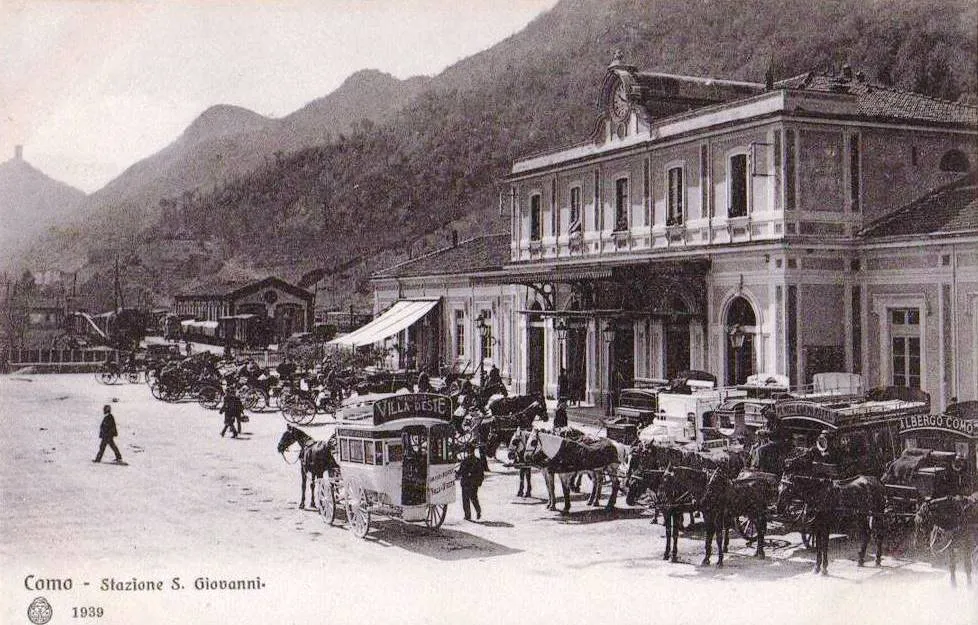
The old Como San Giovanni station- now demolished
The tour starts at Como San Giovanni railway station. Arriving these days , the traveller passes by the cemetery and a series of light industrial buildings. In the 1930s , this was an industrial city as well. Industry in Como was based on textiles and mainly silk . It was the Macclesfield of Italy , if only Macclesfield had such a nice lake. The train line passed the large dye factories , tintorie which supported the silk factories. Most of the ties in Italy were probably made in Como and dyed with the products of the tintorie. . The dye factories, the remains of which can be seen by the occasional still standing chimney, became a centre of resistance following the German occupation. Before the Swiss joined the Schengen zone, Como was a frontier railway station with customs and border inspections ( if any these now take place in Chiasso). The current station is a modern postwar construction. Due to its strategic location, the Como railway line received some bomb damage during the war and the old station is no more. From the photos it looks much more suitable as a entry point to a lakeside resort. In fact the discerning traveller from Milan, might have preferred to take the train from Milano Cadorna to the lakeside station instead.
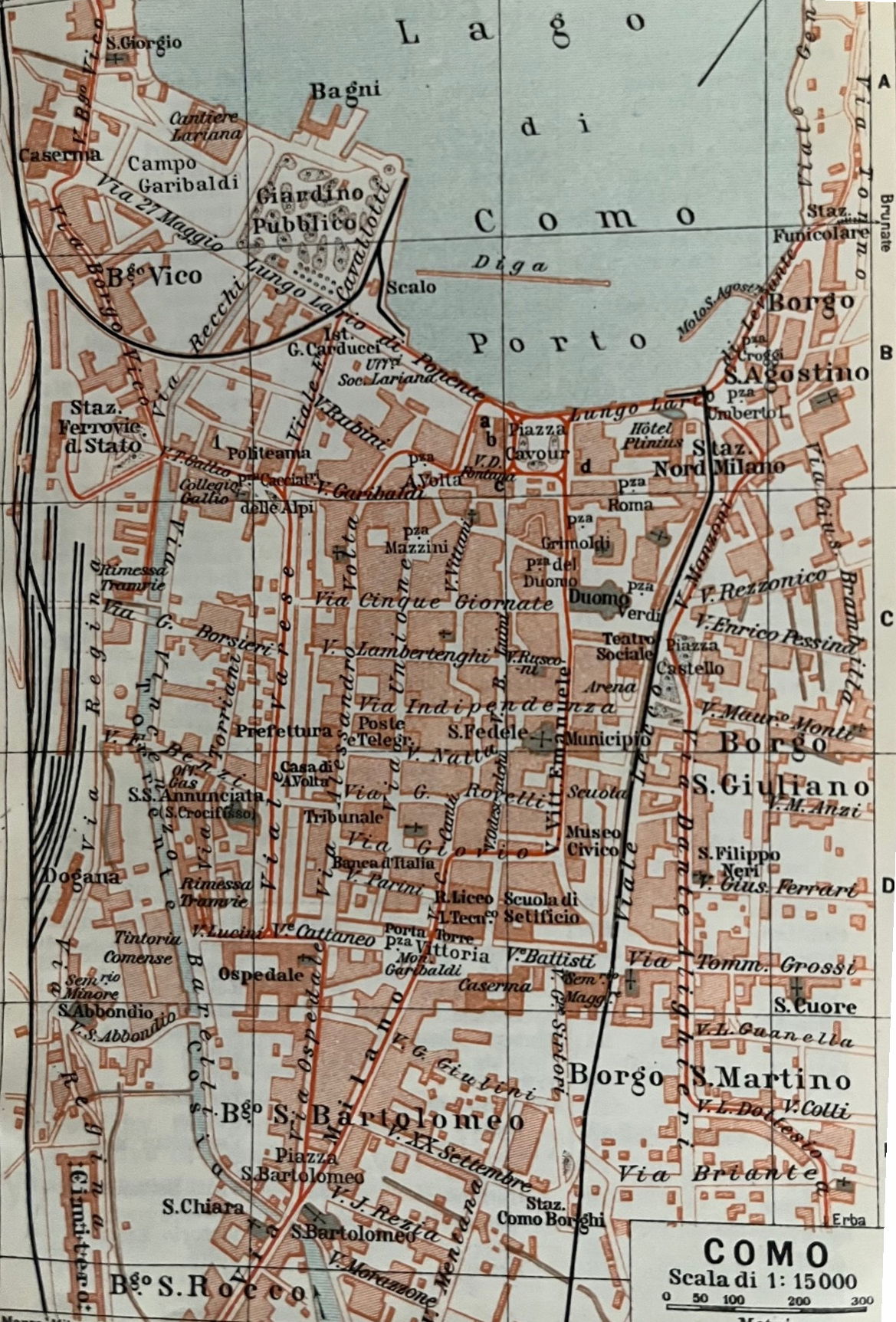
Como from a 1920s map. The football stadium has still to be constructed in the Campo Garibaldi. The location of the Tintoria Comense and its extensive site can be seen towards the bottom. The Torrente Cosia was paved over in the 1920s and is now a road.
By April 1945 , Como was under German occupation and as the multinational Allied Armies moved up the Italian Peninsula , it became a final refuge for the remains of Mussolini's rump Italian Social Republic ( RSI). For Como, Shakespeare's phrase became appropriate
“Hell is empty, and all the devils are here”.
Walking down from the station towards the lakeside, one passes the former offices of the Nazi Rusting und Kriegproduktion in an institutional building now apparently a school. Most of the Germans nominally in charge of industry in the RSI were based at offices in the Foro Bonaparte near the Castello in Milan, Como was somewhere for the administrative offices away from the risk of Allied bombing.
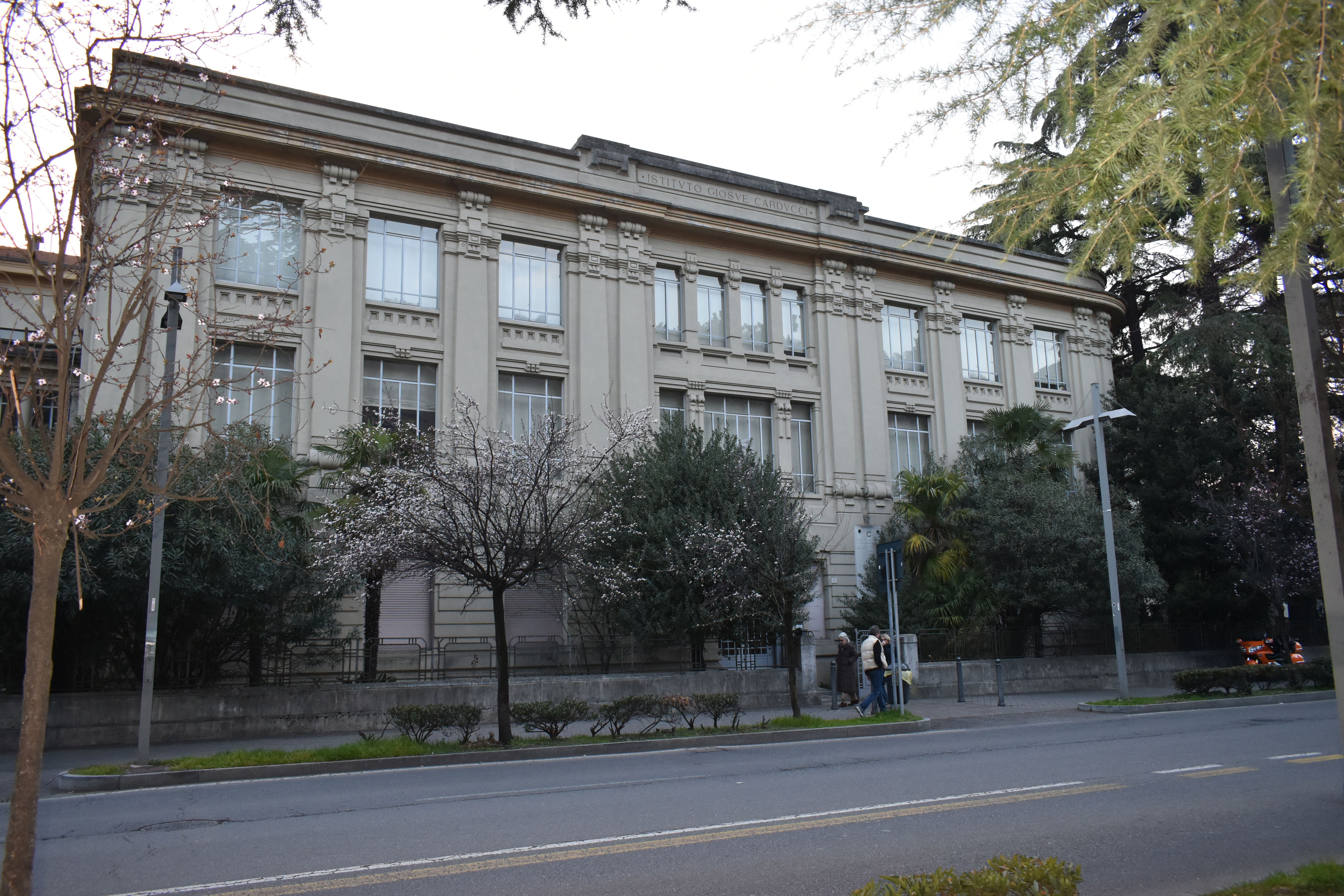
The former HQ of the Rusting und Kriegproduktion from where the Germans despoiled the Italian economy
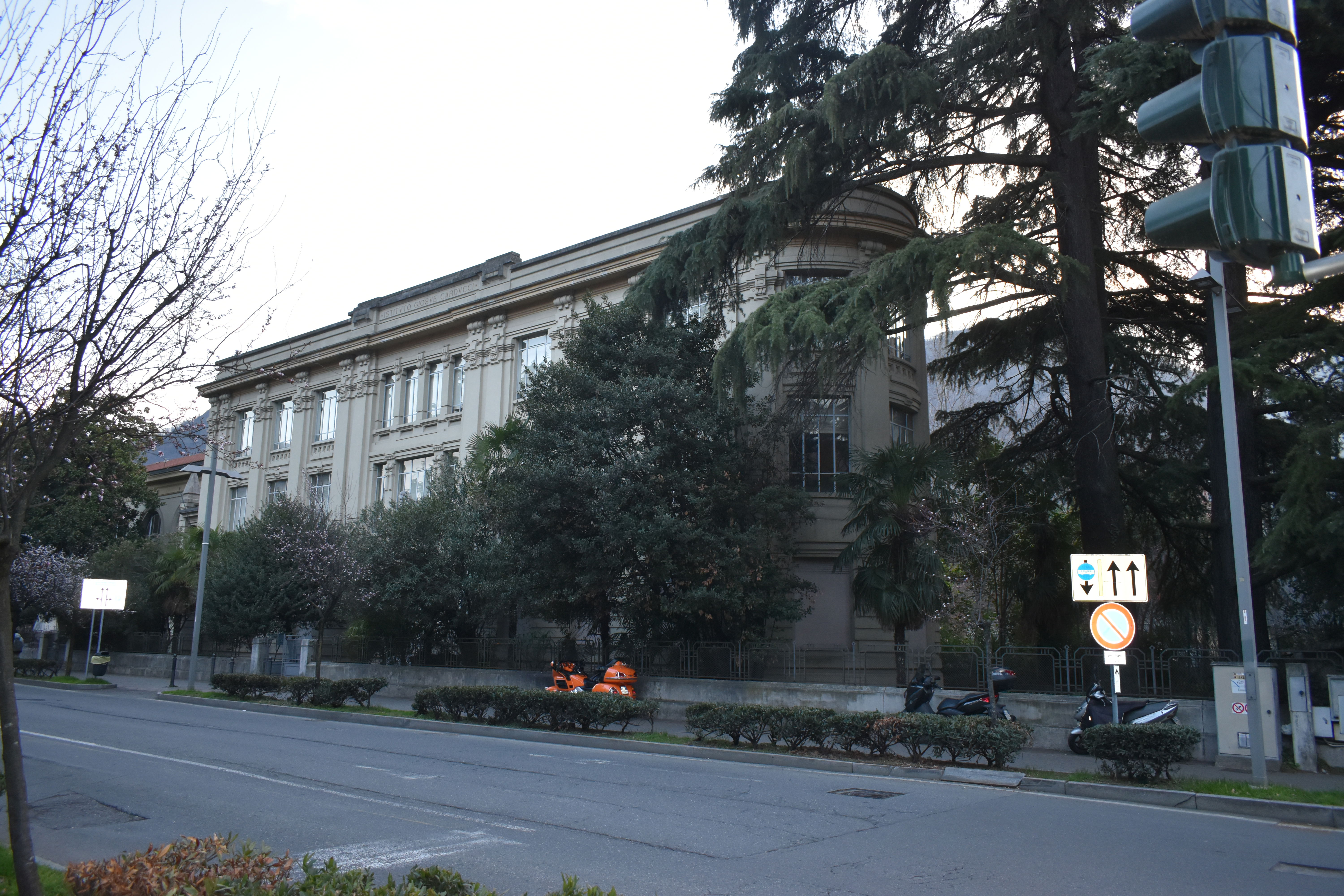
The RuK from another angle
Across the road and very handy for work, was the residence of Hans Leyers. , who since 13 September 1943, had gone by the rather grandiose title of General Plenipotentiary for Italy to the Reich Minister of Armaments. Leyers’s task was to place the industry of northern and central Italy at the disposal of the German wartime economy, together with procuring supplies and food for the German troops based in Italy. He was apparently also responsible for the construction of some of the defensive constructions along the Gothic Line, probably with the assistance for force labour provided by the Organization Todt. On a more positive note, Leyers was also responsible for sheltering the German conductor, Herbert von Karajan . Despite his early association with the Nazi Regime , Karajan had fallen from favour and in November 1944 fled to Milan with his wife ( the immediate reason might have been a pending enrolment in the Sudstern, a Nazi propaganda battalion). According to the accounts of a Milanese dentist and the , possibly less than the truthful, testimony of Theodor Saevecke the Head of the SD in Milan, It was Leyer’s who managed to hide von Karajan and wife at the Villa D’Este in Cernobbio ( at the time requisitioned by the Luftwaffe as a hospital). Presumably ,( if it all true ) Leyers would have been helped by his proximity to Cernobbio. Leyers was also important in protecting Italian capitalism. Mussolini’s Social Republic was keen on “ socializing “ Italian businesses, this was of course, inimical to the Nazi’s who had got where they were with the support of German Capitalists and did not support the concept of socialization.
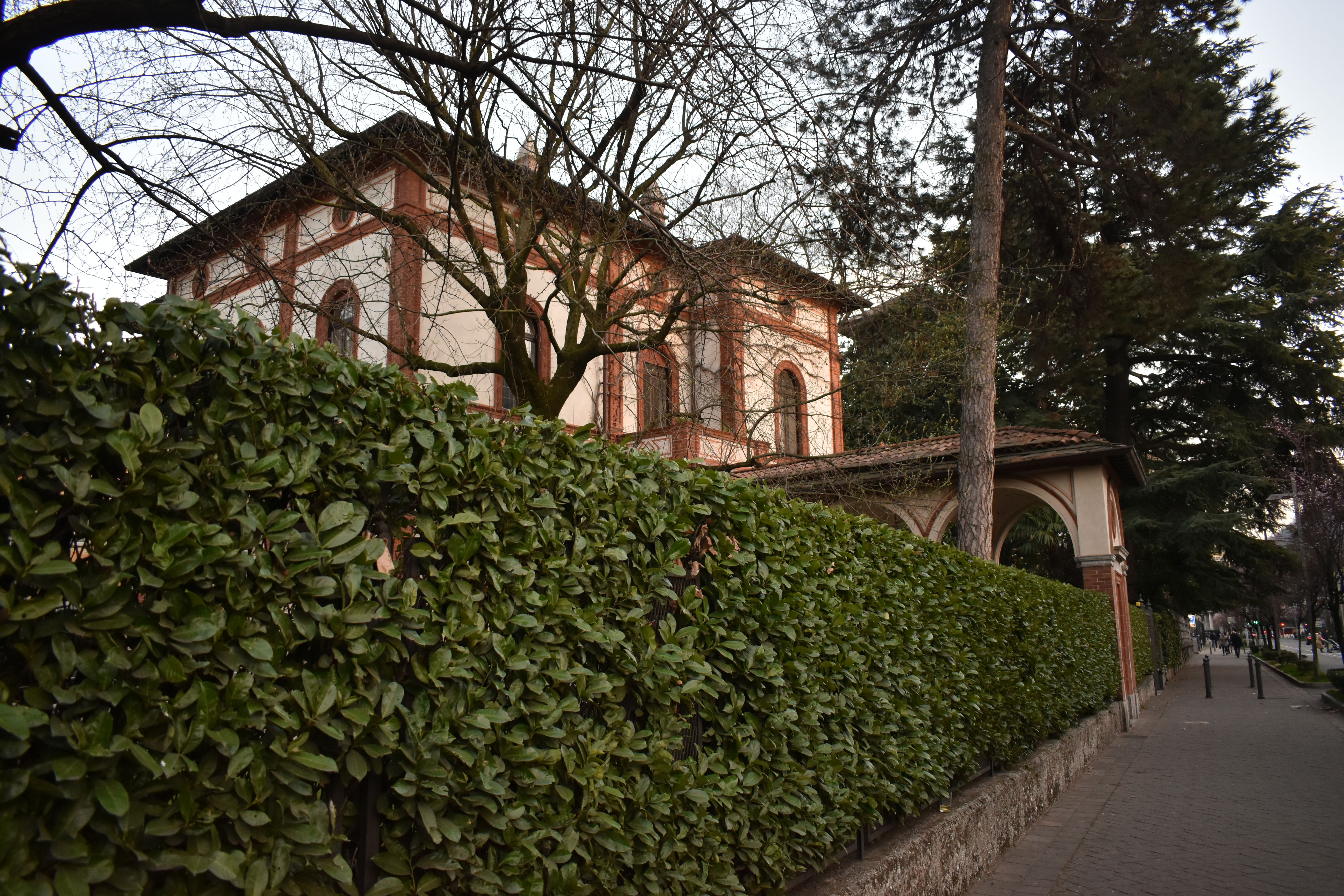
The villa requisitioned for Hans Leyer- just across the road from the RuK and of course-with a lakeview
What with pillaging the Italian economy, keeping it safe for capitalism and protecting composers, Leyers had much to ponder on, as he surveyed the rather fine view across the public gardens and up Lake Como. As we have seen in Monza and Milan, the Germans did have a penchant for requisitioning some very nice Italian buildings for their wartime use. These days Leyers would have found his view somewhat interrupted by a monument to slave labourers from across Europe, which has been built in Como’s lakeside park, which is ironic.
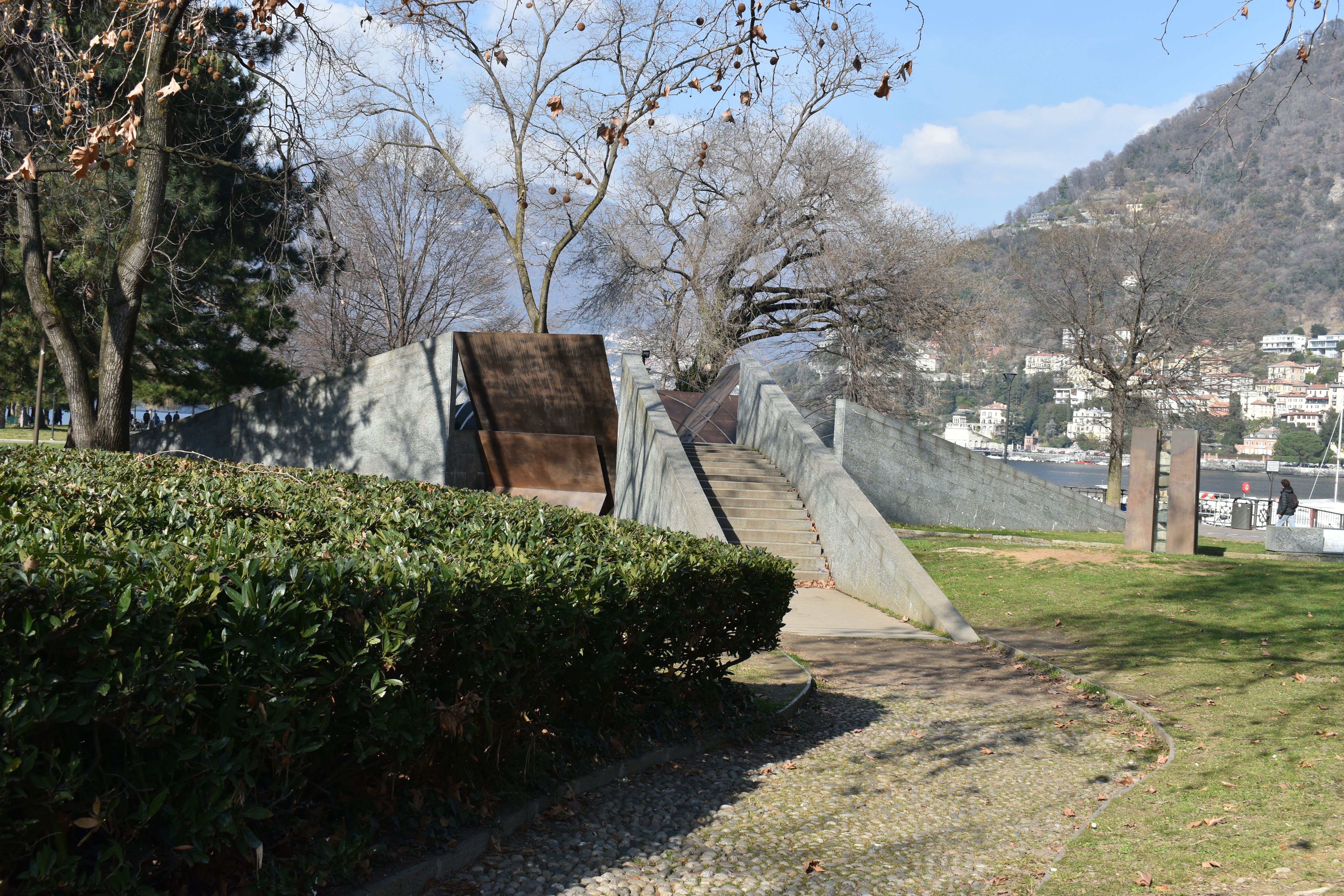
The German Wehrmacht had taken over much of Como’s Lake front. The whole area from the park to the football stadium and the seaplane landing was under their control. They occupied the first floor of the Novocomum apartment building, a fine example of Italian rationalist architecture which is still there today. The Novocomum building was designed by local architect Giuseppe Terragni, who was also responsible for the giant war memorial on the waterfront and the Casa del Fascio ( of which more later).
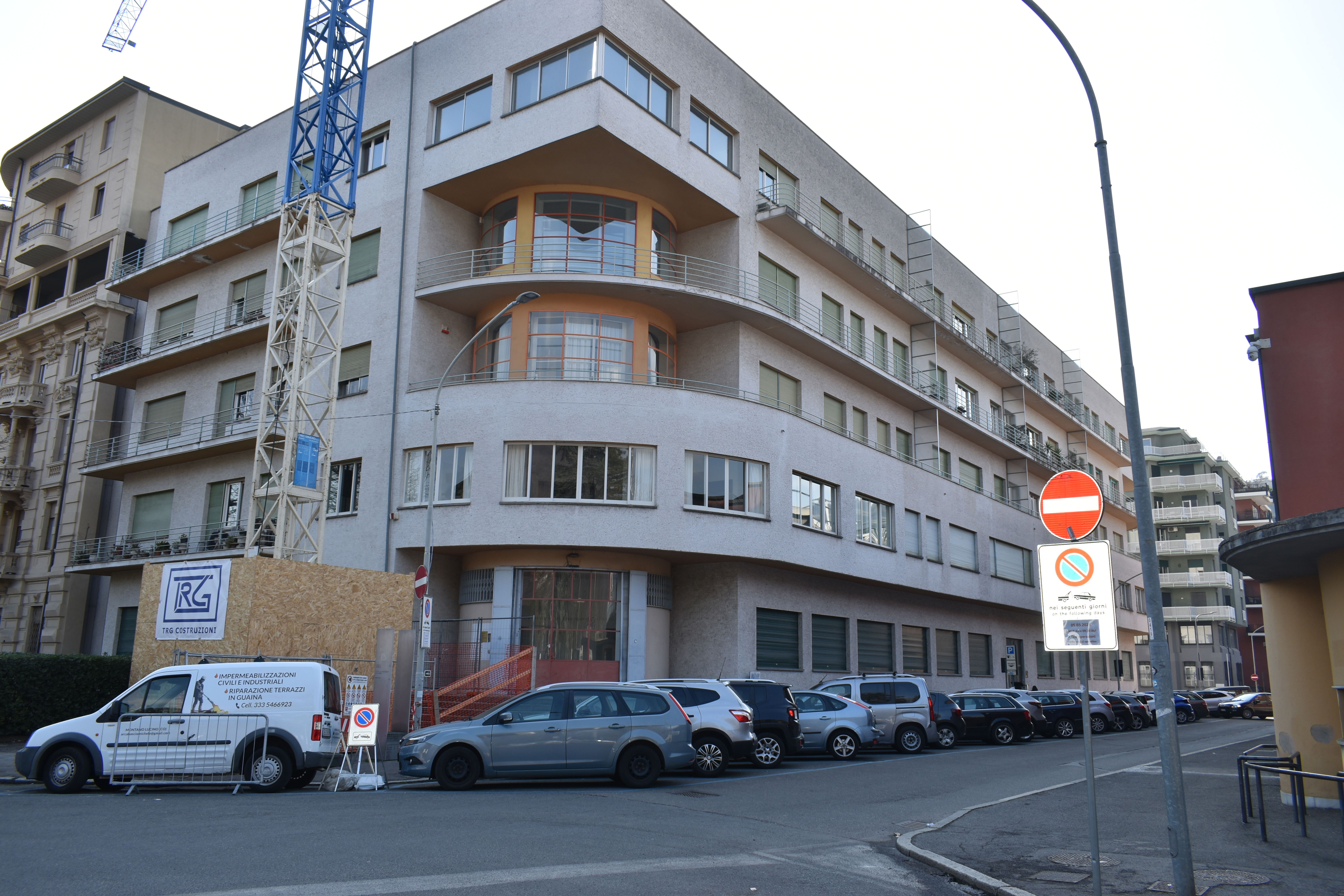
Local rationalist architect Giuseppe Terragni designed the Novocomum building
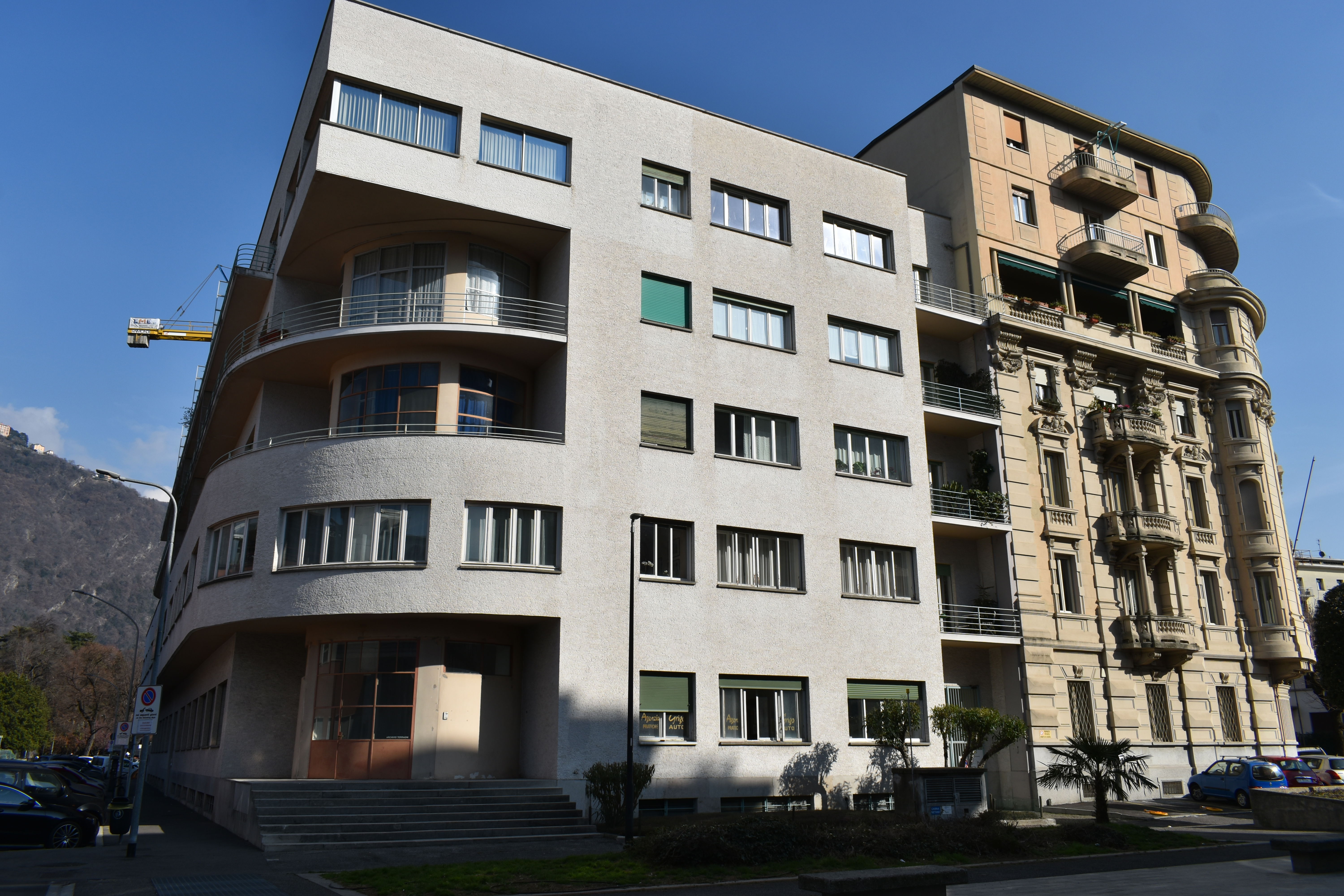
During the war it was occupied by the Germans
The Wehrmacht occupied a number of buildings ringing the Stadio Sinigaglia, the home of the Como Football Club. Although clearly modernized since those days, the stadium maintains its basic structure and certain parts of its reinforced concrete look original. It really is one of the world’s most pleasantly located football stadiums, from the top seats facing the lake it must be difficult to concentrate on the football, rather than the rather splendid view.
The Germans also occupied the Rowing Club, another rather fine rationalist building, next door to the war memorial. The War Memorial may have served as a rather painful reminder to all sides, that the Italians had been on the other side in the last war. Como was of course, a perfect spot for canoeing and the Stadio Sinigaglia, was named after the champion Italian rower,. Giuseppe Sinigaglia who had lost his life on the Carso fighting Austrians in the First World War. On the other side of the stadium the Germans also made use of the Idroscalo. (Given it long coastline and lakes, in the 1920s Italy was at the forefront in developing both floatplanes and a network of places for them to land.- idroscali. Even Milan had its own artificial idroscalo) The main structure , including the hanger was another design by Giuseppe Terragni and had been finished in 1931. It is still operating as a flying school and float plane base today.

The Rowing Club
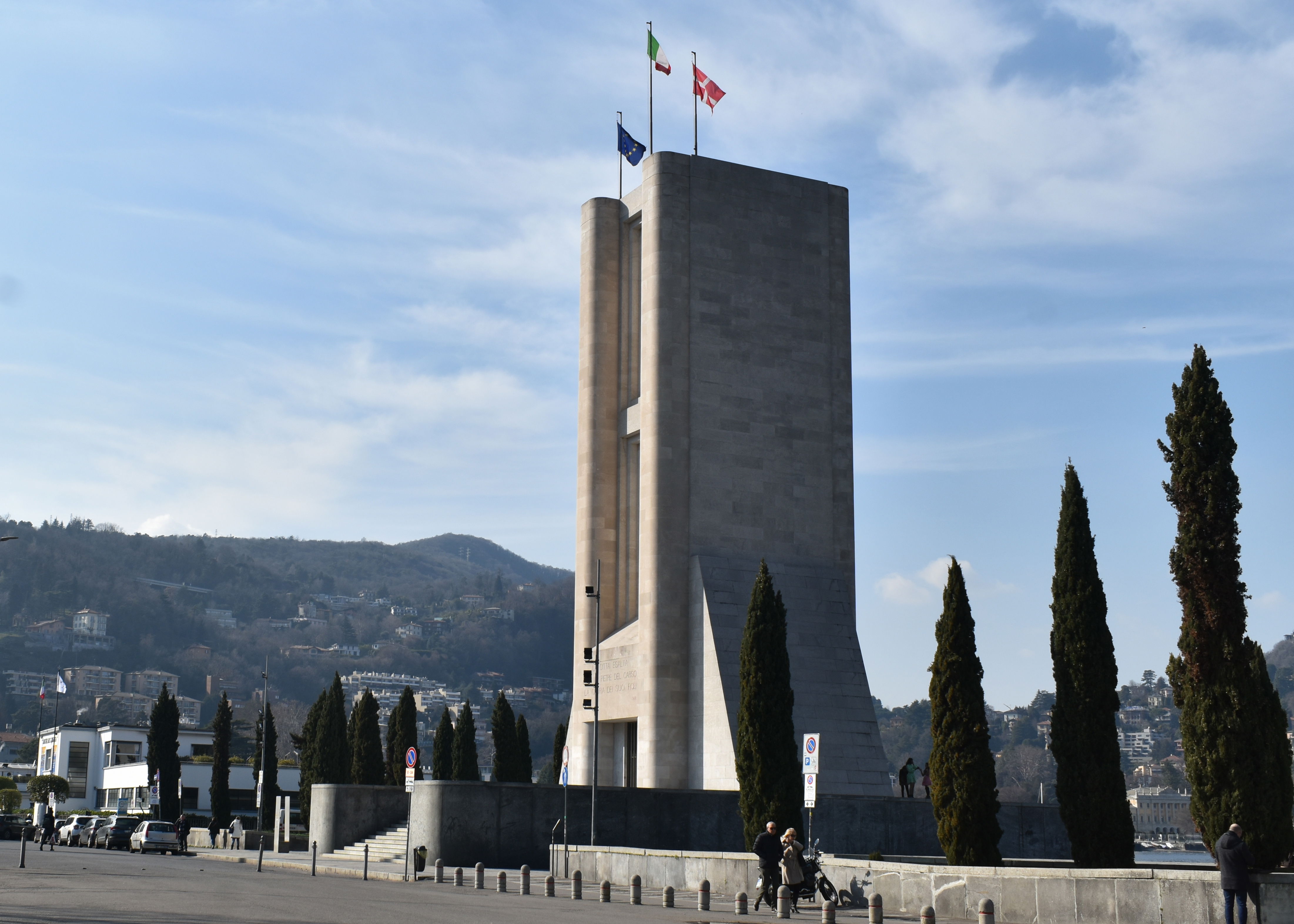
The War Memorial
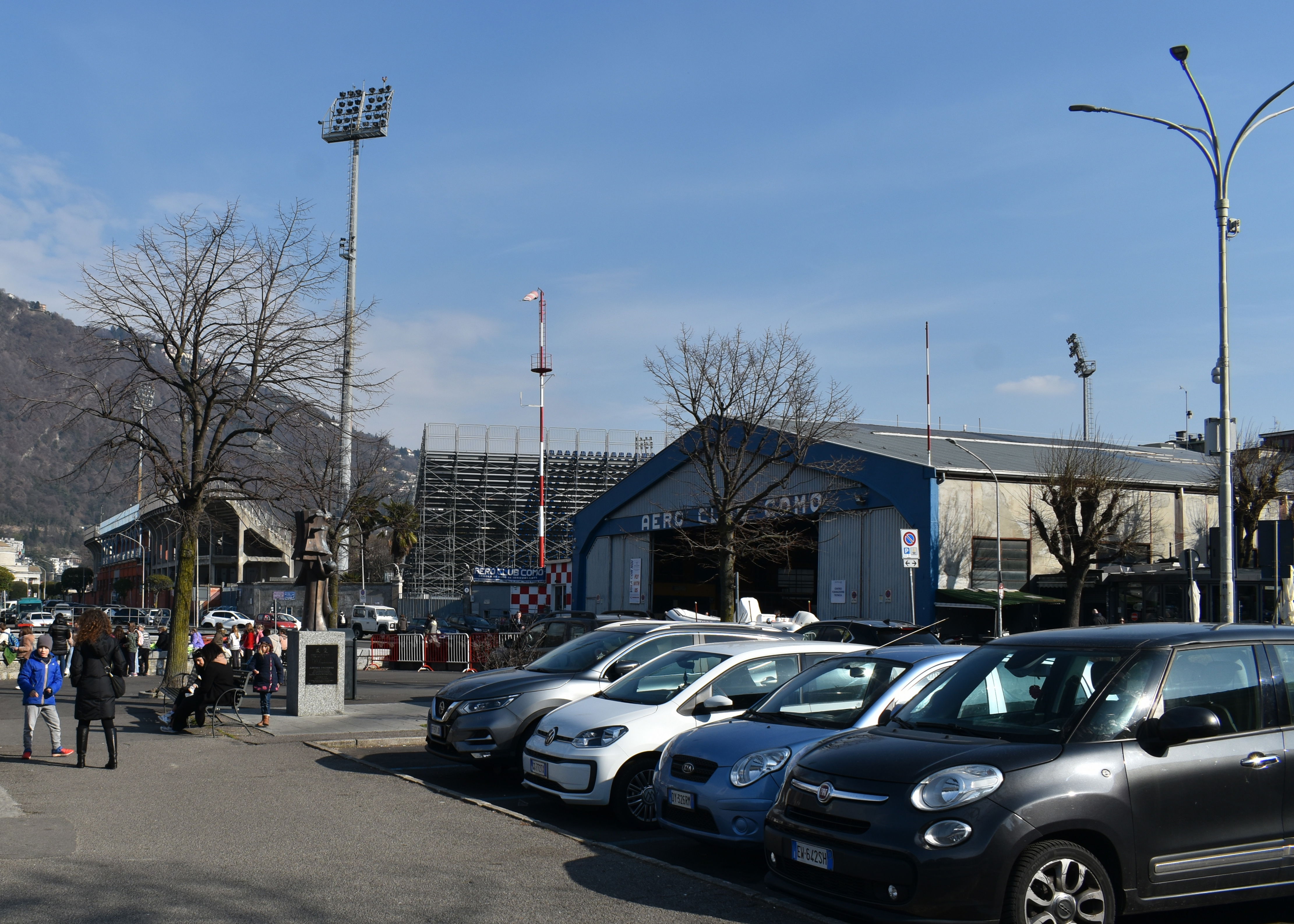
The hydroplane station- all designed by Terragni
Further down the lake front, the Germans true to form had taken over a number of the fine villas. Apparently, Dr. Ing. Karl Wiskott who was responsible for the Italian Automotive industry had established himself at the Villa Crespi ( also known as the Villa Gallia- the trouble with Italian villas is that they change names quite frequently) ) . Wiskott had previously been responsible for looting the automotive industry in occupied France., before moving on to Italy to do the same.
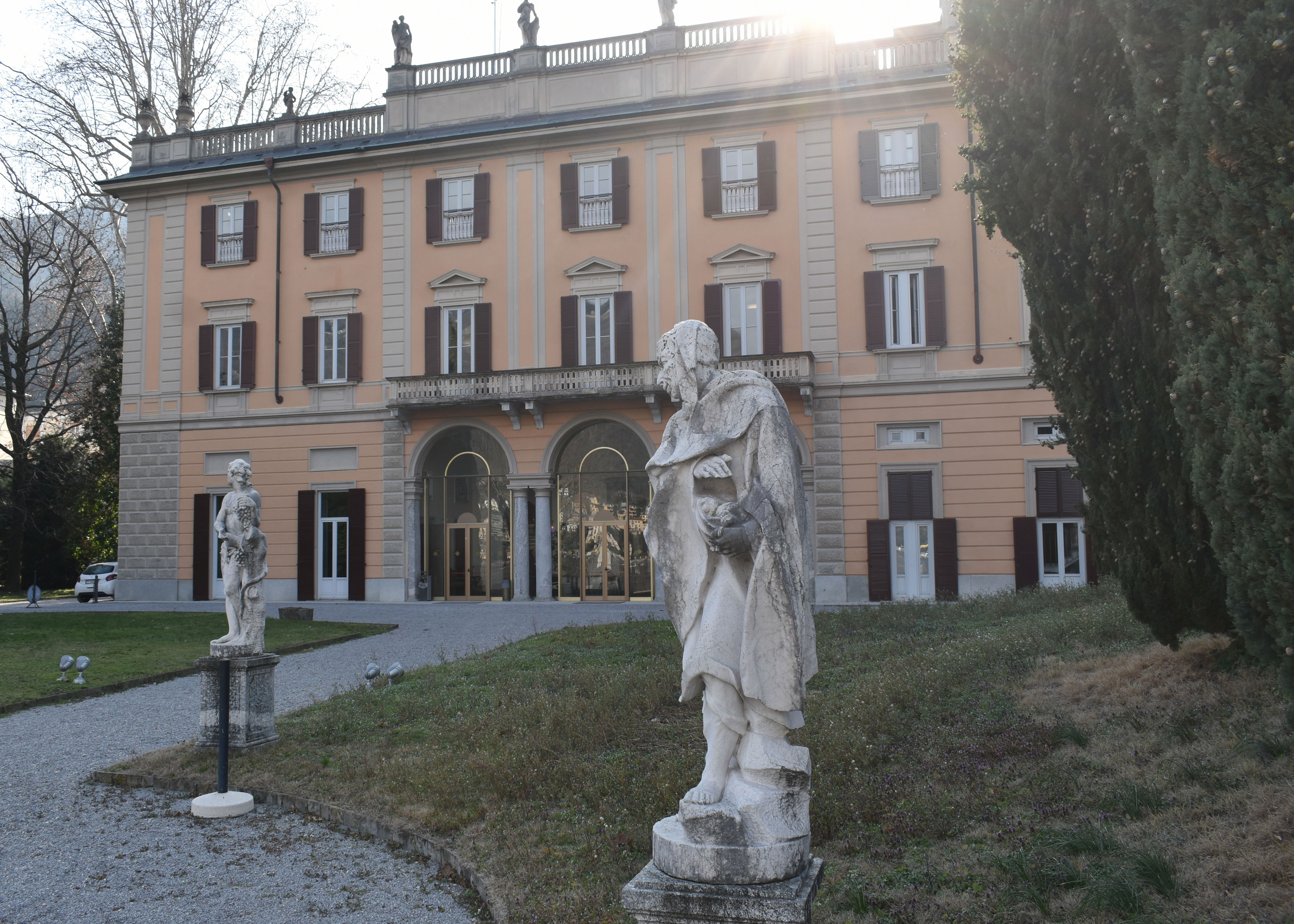
The Villa Gallia ( formerly the Villa Crespi)
Behind the lakeside villa, you notice a somewhat incongruous red brick chimney. A reminder of Como’s industrial heritage . This was the Tintoria Pessina , between the Cosia River and the via Carloni. ( The river is now culverted and below the road) .The chimney is all that remains of a factory that used to employee several hundred people . now incorporated into a residential complex. The factory was established by Bruno Pessina, whose family were important in the Como dye industry. Bruno died in the 1930s and it was bought out by another company Solbati. In March 1944, the strike action at Pessina was suppressed before it got going. The factory kept going until 1976, producing dyes and fabrics.
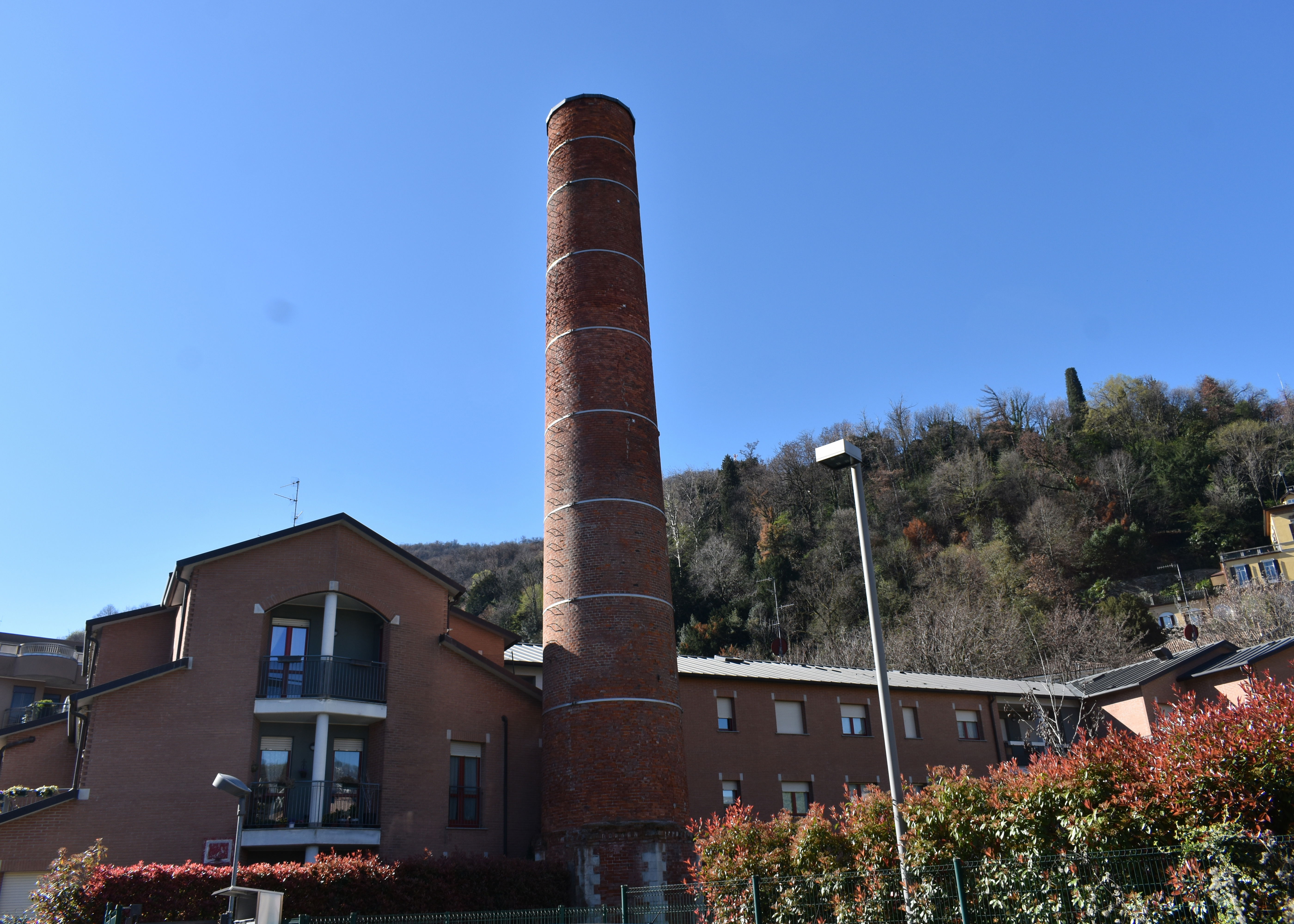
The former Pessina dyeworks near to the lakeside,. A reminder of Como's industrial past
Continuing along the lakeside past the Villa Olmo, up on to the footpath along the lakeside, through Tavernola, we reach the lakeside resort of Cernobbio. Not surprisingly, the Germans established themselves here as well. The Luftwaffe requisitioned the Villa D’Este as a hospital, which as military hospitals go, must have been one of the better ones to be in. It was also, where Leyers had contrived to hide Herbert von Karajan. Around 27 April, the Germans left the villa and a long convoy of 22 trucks evacuated the most badly injured across the Swiss border and into internment. Clearly these days, it is a very upmarket hotel again, so you may have to pay a high price for a drink to get a look around.
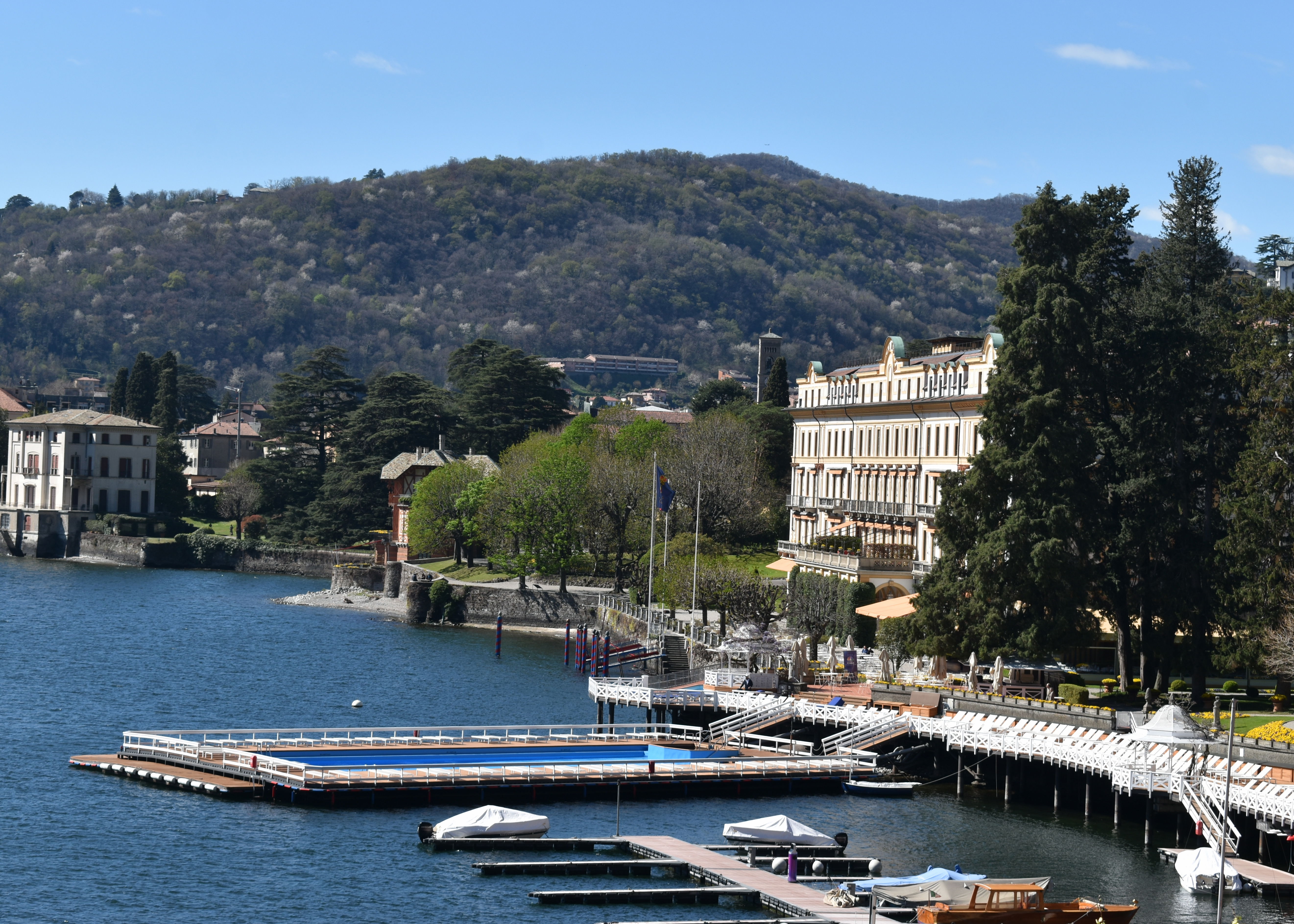
THE villa D'Este, Cernobbio. Now a luxury hotel, in wartime, it was used as a Luftwaffe Hospital
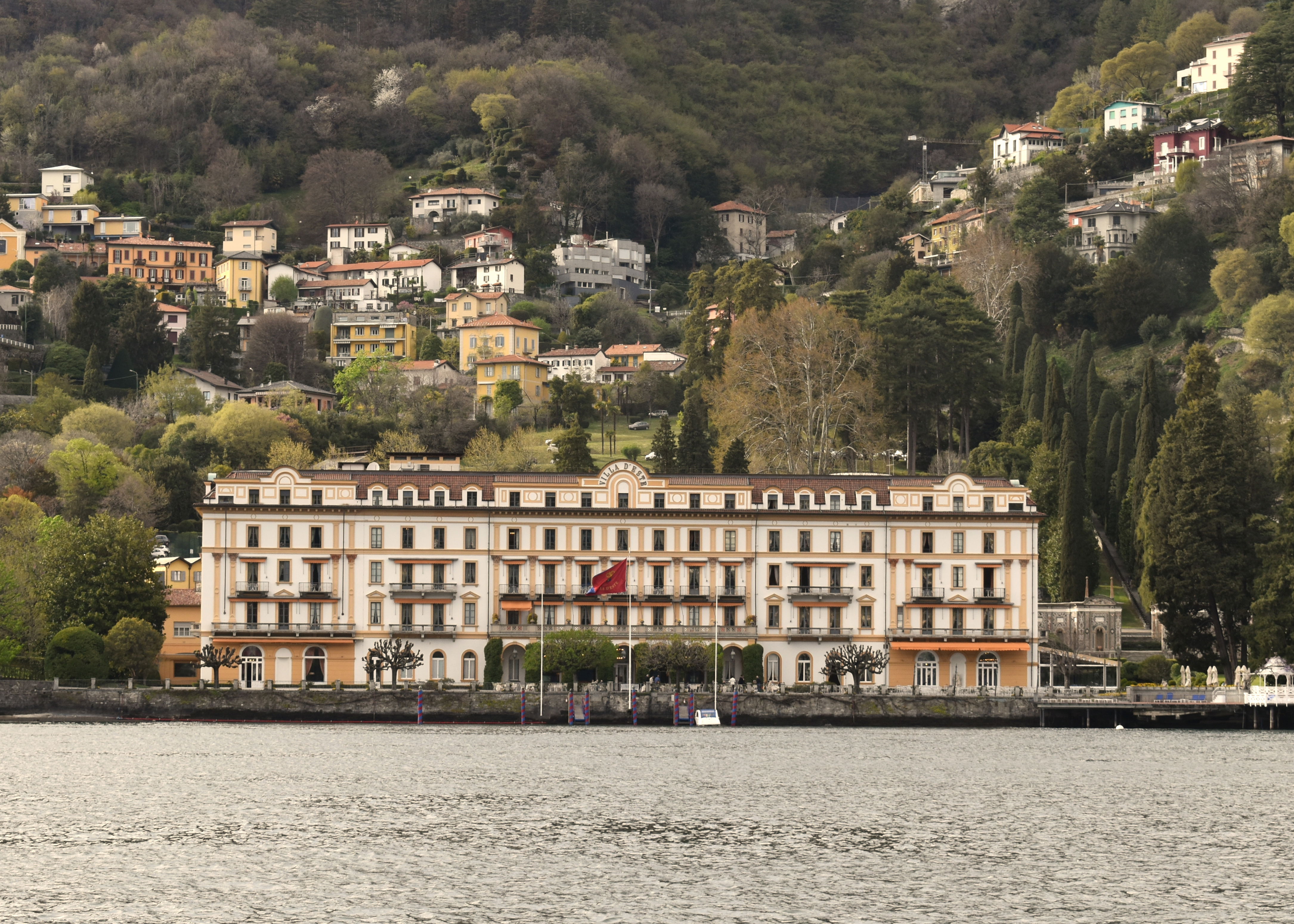
The villa D'Este from the lake. German conductor Herbert von Karajan his here after fleeing Germany.
The Hotel Miralago in the main square of Cernobbio was also used by the Germans. Next to the square and the landing stage, the villa Gertrude Locatelli hosted a detachment of the SS. Up the hill on the road to Rovenna, the Villa Carminati was the base for the German Frontier Police.
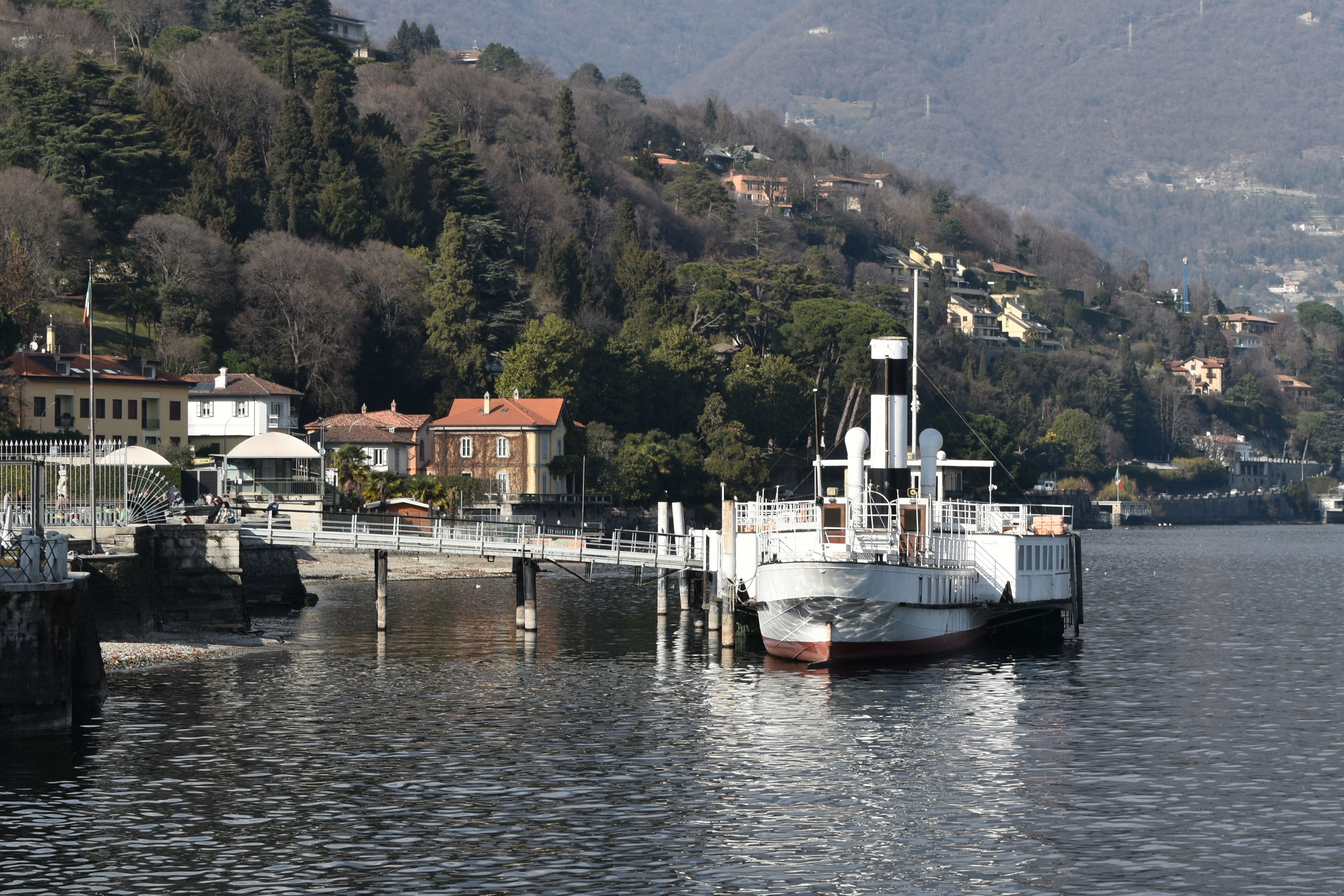

The Albergo Miralago in Cernobbio, also apparently used to billet German troops during the war
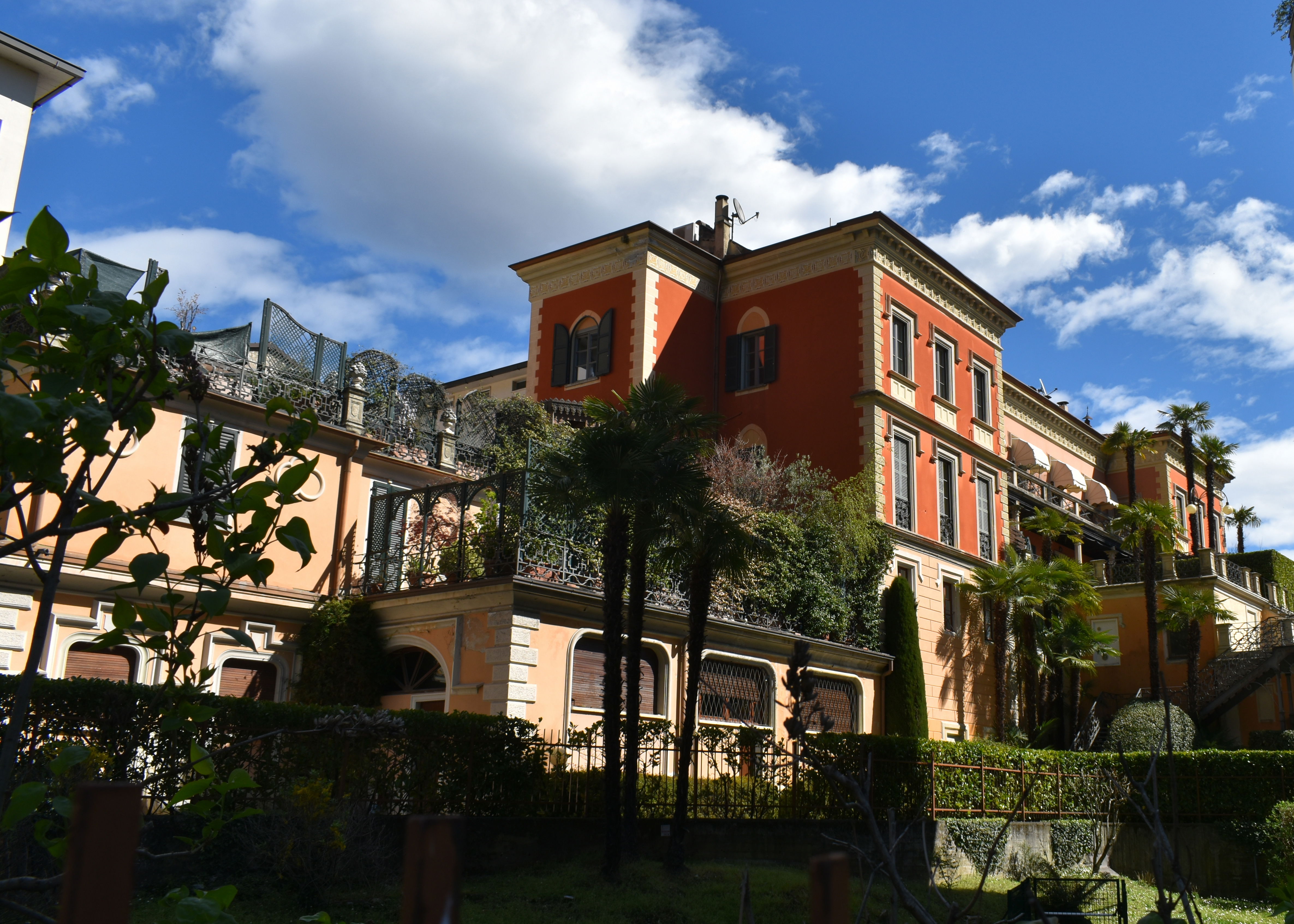
Villa Carminati in Cernobbio- base for another SS detachment
The Villa Locatelli became the site of some dramatic scenes in the last days of the war. SS General Karl Wollf had been conducting secret surrender talks with Allen Dulles of the OSS in Switzerland since March. By April , the Soviets had found out about these negotiations and with the Americans fearful that they would be seen as trying to negotiate a separate peace with the Germans , Dulles had been told to desist with the tasks. Nevertheless, Wolff had continued his negotiations with Swiss Intelligence , through the good offices of Colonel Max Waibel. On 25 April Wolff was heading back to his HQ in Bolzano from Waibel’s house in Lucerne and stopped off at the Villa Locatelli in Cernobbio.
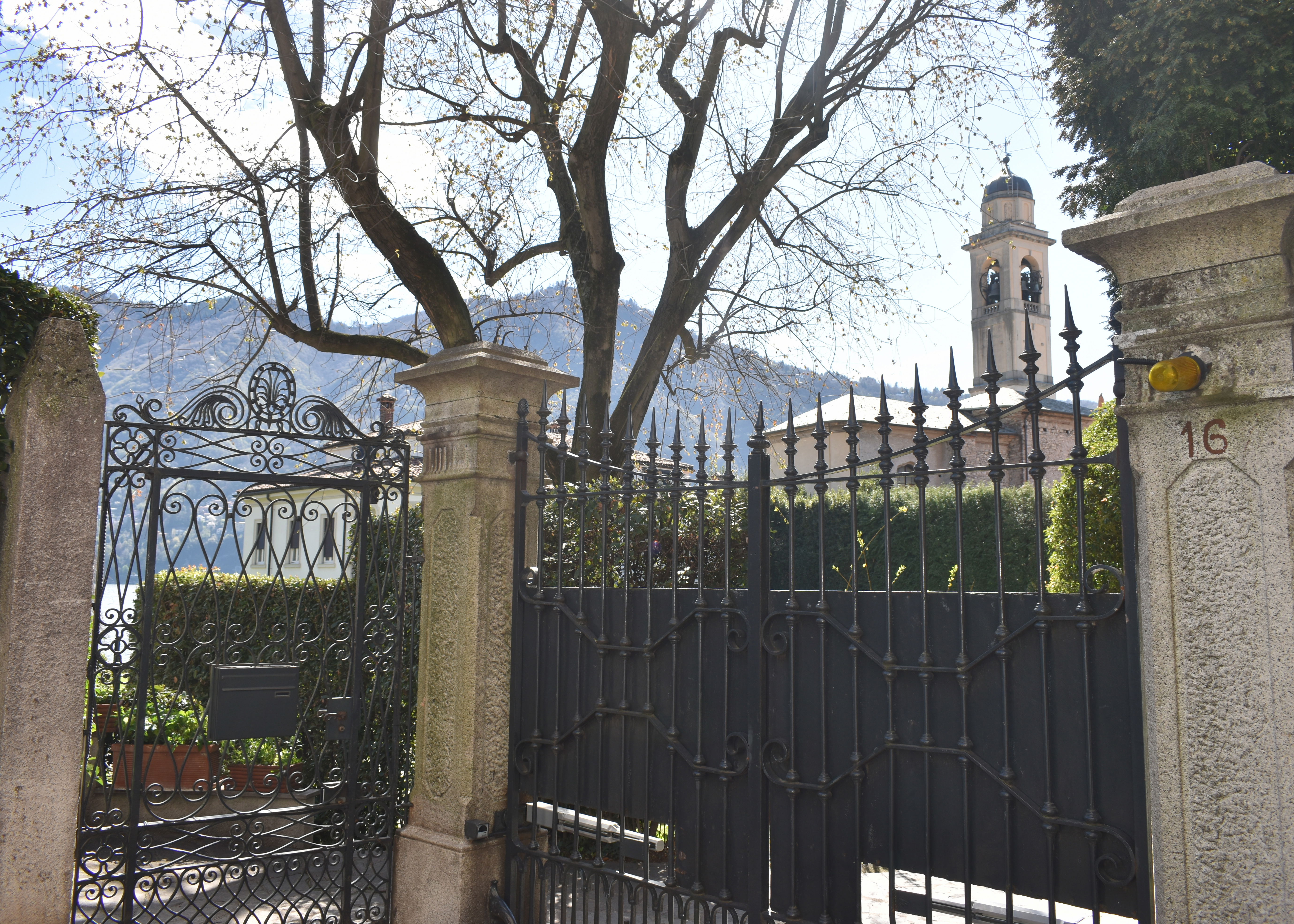
Somewhere behind the gates is the villa Locatelli or villa Gertrude. Requisitioned and occupied by the SS and site of some dramatic scenes in the final days of the war.
Wolff found that the Villa was surrounded by partisans and that he was trapped. Wolff tried to arrange with Colonel Walter Rauff commanding the SS in Milan for Cardinal Schuster, the Archbishop of Milan to arrange a rescue mission to get him back to Milan. Rauff reported that the road to Como was blocked by partisans and they would not get through. Wolff then managed to send word to Allen Dulles in Bern regarding his predicament. Still hoping that Wolff could deliver on the surrender of German forces in Italy, Dulles felt compelled to save the General. He entrusted the task to OSS Agents Donald Jones ( zio Scotti) and Emilio Daddario based at the US Consulate in the Swiss city of Lugano.
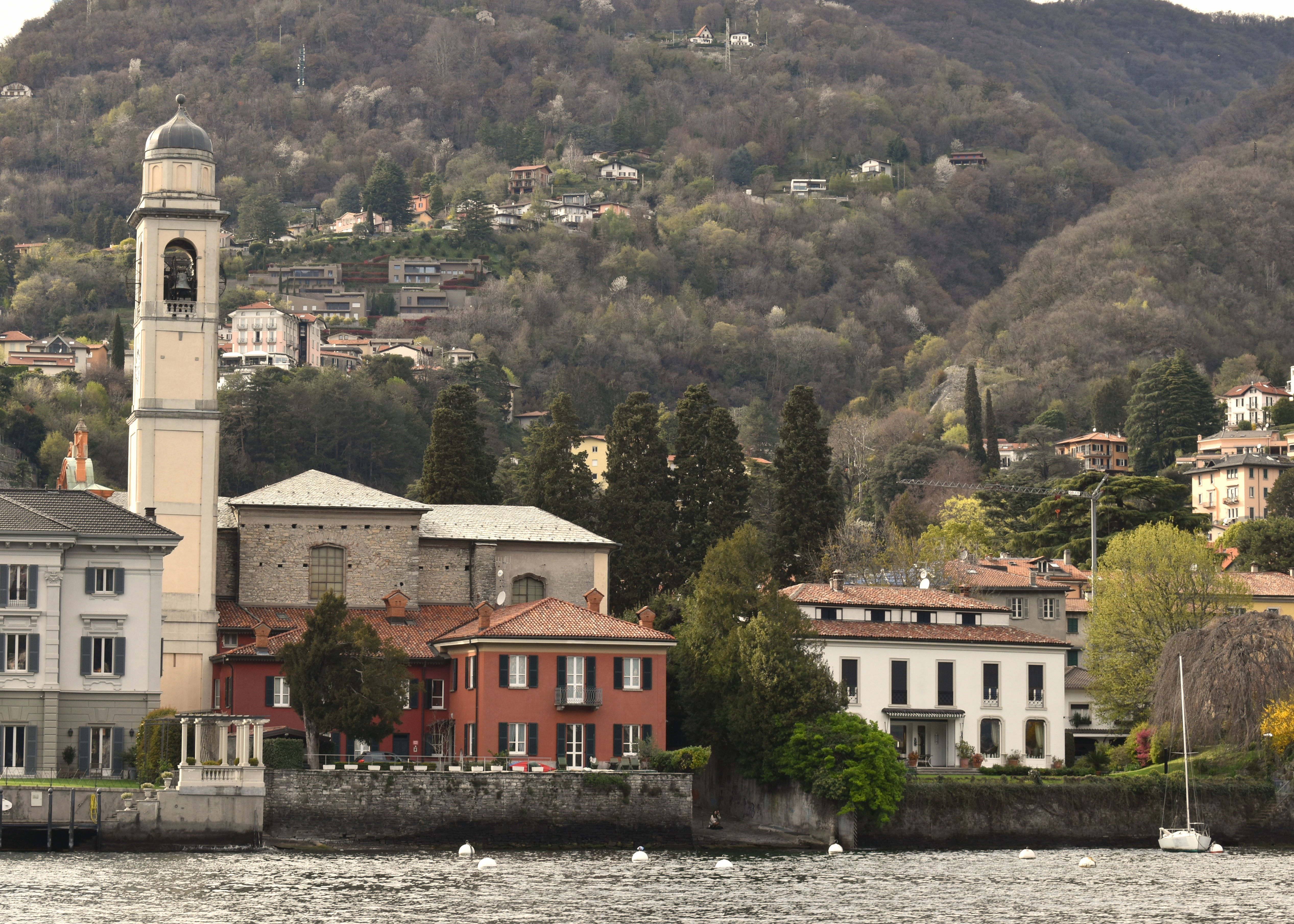
Cernobbio and the villa Locatelli seen from the lake
The same day , with American troops moving rapidly towards the south of the city , an insurrection had started in Milan. As street fighting spread across the city, Mussolini, and Marshal Graziani the head of the RSI’s Army were holed up in the Archbishop’s Place in Milan , in talks with the CLN . At around 1900, Mussolini learned of the progress of German surrender talks with the allies and convinced that he had now been abandoned , decided to strike out on his own, Mussolini. Graziani and other senior Fascists headed north from Milan in the evening , their intentions were not particularly clear- the Swiss had made it fairly clear to Mussolini that he would not be admitted, so maybe they were heading for the fabled Valtellina redoubt or trying to get to Germany.
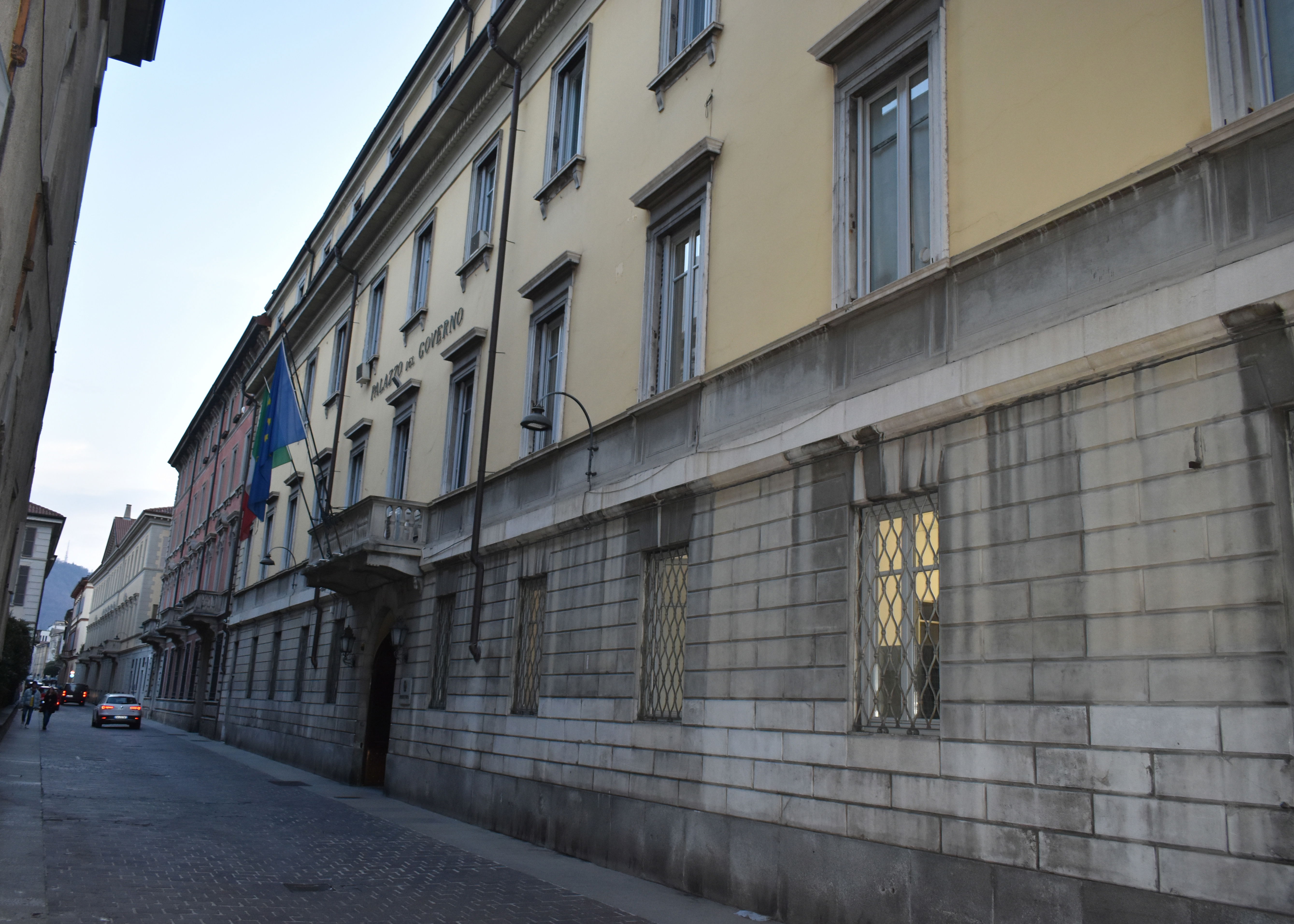
The Palazzo del Governo- Prefecture of Como, where Mussolini's party arrived on 25 April 1945
The party reached Como without incident at around 2300 , where they found generale Leyers waiting for them. They were escorted to the Prefecture in via Volta to camp for the night, the prefect Dottore Celio may not have been there to greet them, since he had apparently spent most of the day negotiating with the partisans, who were surrounding the city. Eventually he turned up and his wife prepared supper for the guests. Mussolini stayed in a side room holding consultations, apparently he was preoccupied about a truck that had been left behind somewhere . The Federale of Como , Paolo Porta proposed that the part retreat to a villa at Cadenabbia controlled by his Brigata Nera with 1900 men and they then blow up the galleries on the road along the lake . At around 5 am on 26 April, Mussolini’s column left the prefecture and headed up the lakeside road to the North.
Graziani parted with Mussolini at Como and in the company of Air Minister Bonomi and generale Sorrentino, headed for the villa Locatelli in Cernobbio. Here they found General Wolff, After a discussion, . Graziani gave Wolff the power to conduct surrender talks on his behalf. With the villa now surrounded by partisans, Graziani sought only surrender terms for himself, Bonomi and Sorrentino with the “honour of arms” , in a letter to Cardinal Schuster in Milan, he sought protection for his return and surrender to Generale Cadorna of the CLN. The rest of the evening between Wolff and Graziani must have been fairly tense. Wolff in full SS uniform waited his fate. In Lugano on the evening of 26 April, Donald Jones had assembled a motley crew of Swiss intelligence officers, SS men and partisans and headed over the border into Italy. The party soon came under fire from partisans. Fortunately, Jones (Scotti) had a good reputation with the partisans who recognised him and ceased fire. The Scotti party then managed to get into the villa , they persuaded Wolff to change into civilian clothes and key the building at around 2 am , finally getting him back across the border into Switzerland at Ponte Chiasso.
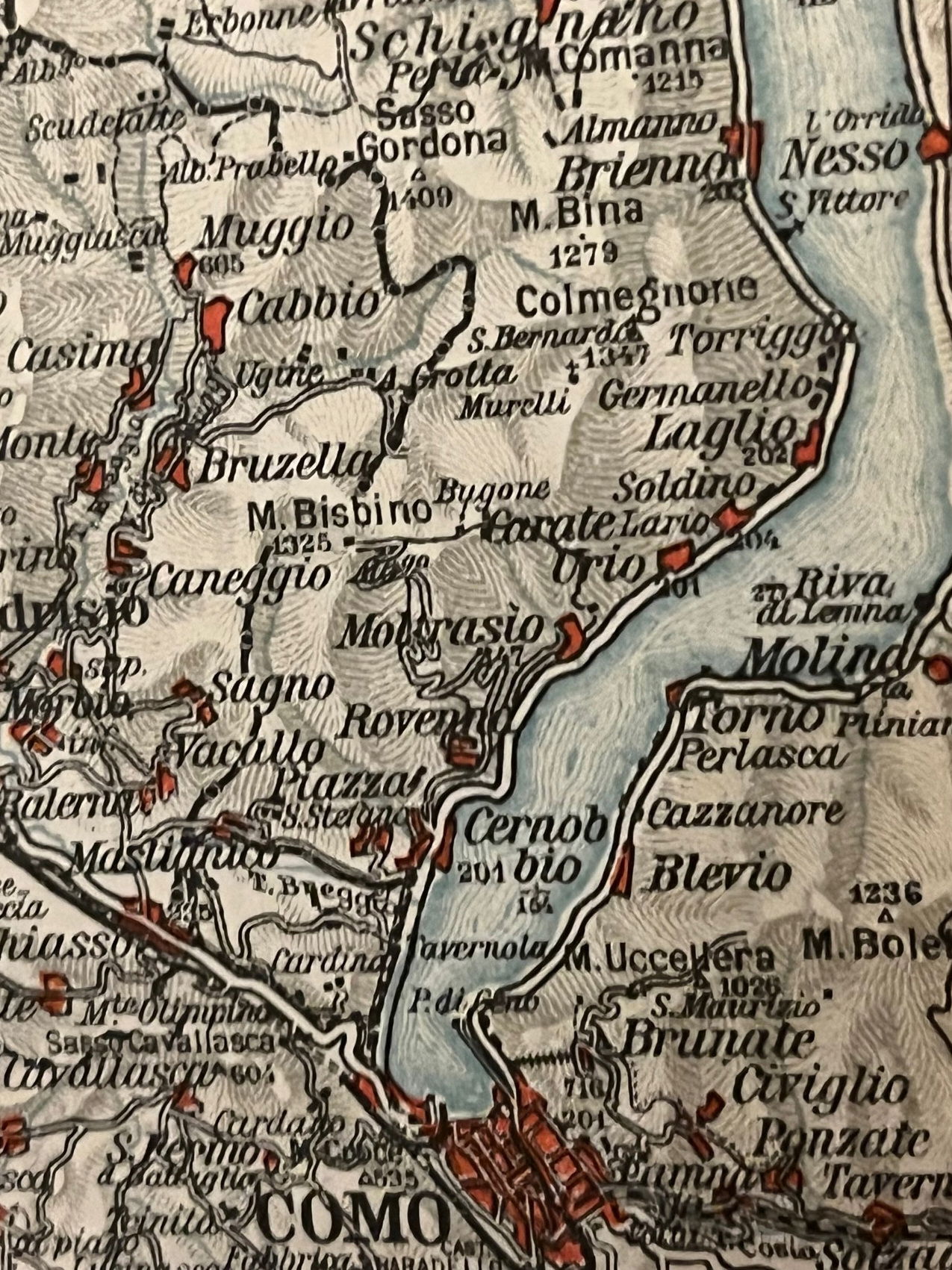
Cernobbio and Como-Before the motorway, it was on the back roads from Cernobbio to the Swiss border at Chiasso
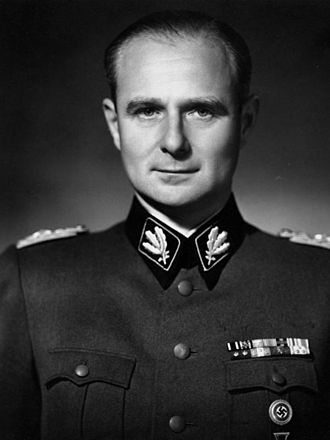
SS General Karl Wolff rescued from the Villa Locatelli by Donald Pryce Jones of the OSS
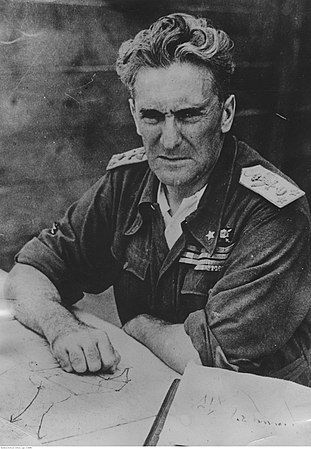
Marshal Graziani , Head of the RSI's Army arrested at Villa Locatelli by Emilio Daddario
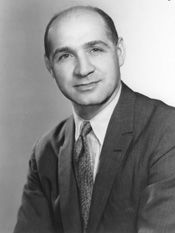
Emilio Q Daddario of the OSS who arrested Graziani at Villa Locatelli and took him back to Milan
Graziani now remained alone at the Villa Locatelli, abandoned by Wolff and his American protectors and surrounded by partisans. He was saved by the arrival of the second OSS agent who from Lugano , Captain Emilio Daddario, who persuaded the encircling partisans to allow him to take Graziani, Bonomi and Sorrentino into custody and arranged for transport to Milan. After paring with Graziani, Mussolini continued along the lakeside road towards his fateful appointment against a wall in Dongo at the far end of the lake. Graziani under American escort ended up a prisoner in the Hotel Milan, Mussolini ended up strung up in a petrol station at Piazza Loreto.
Wolff managed to cross Switzerland and through Austria to Bolzano to arrange an orderly surrender. On 28 April , two German representatives were flown to Allied Headquarters in Caserta to sign the surrender instrument for German forces in Italy . Iy is difficult to look at Cernobbio today and imagine all the drama that took place at the end of April 1945.
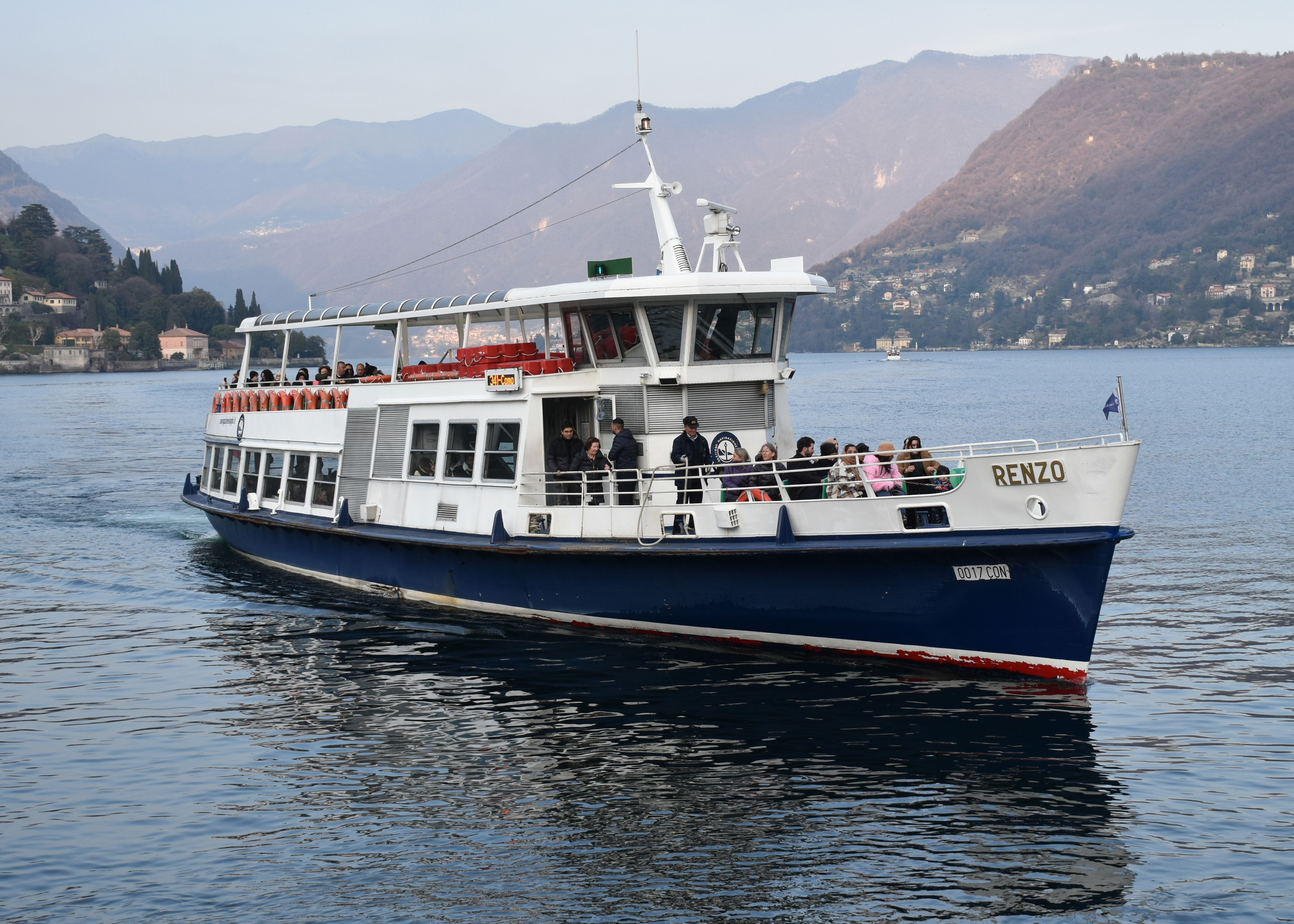
The ferry back from Cernobbio to Como
Leaving Cernobbio , to get back to Como, it is best to take the twenty minute Ferry ride from the Landing stage,. This passes the front of villa Erba, where the Germans apparently used the grounds as a supply dump.
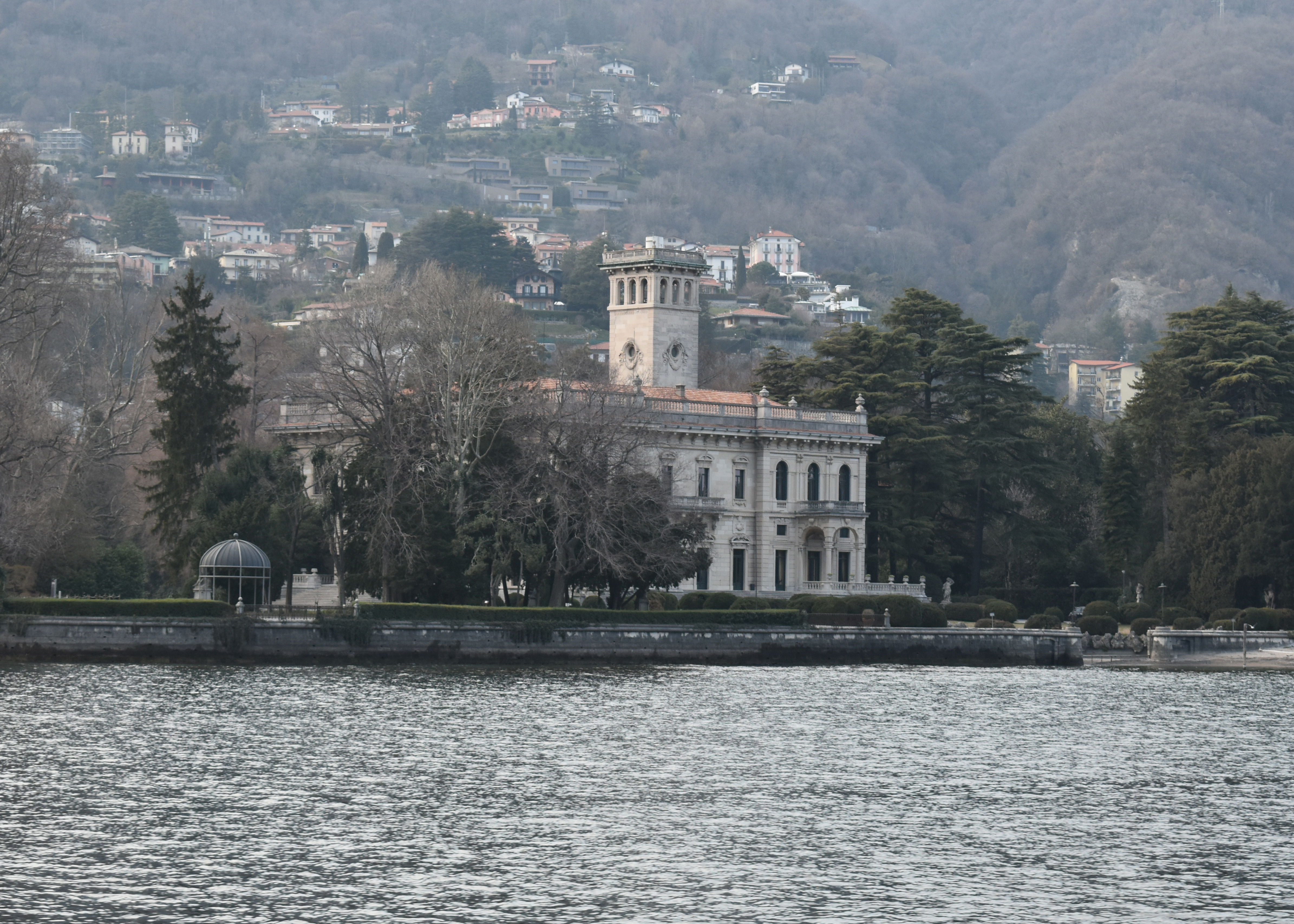
Villa Erba seen from the lake
During the war, the ferry service on the lake did not remain unaffected. After the 25 July 1943, the steamers "Savoia" and "20 Ottobre” were renamed “Patria” and “Concordia” .In 1944 and 1945, despite being camouflaged a number of the lake steamers were attacked by Allied planes. The steamers "Patria “ and “Bisbino” were attacked in mid lake, a total of five people were killed including the Captain of the Bisbino. January 1945 was the worst month for attacks on the fleet, after which Lake navigation was suspended until the end og the war. As a by product of all this they are still finding unexploded ordinance in Lake Como
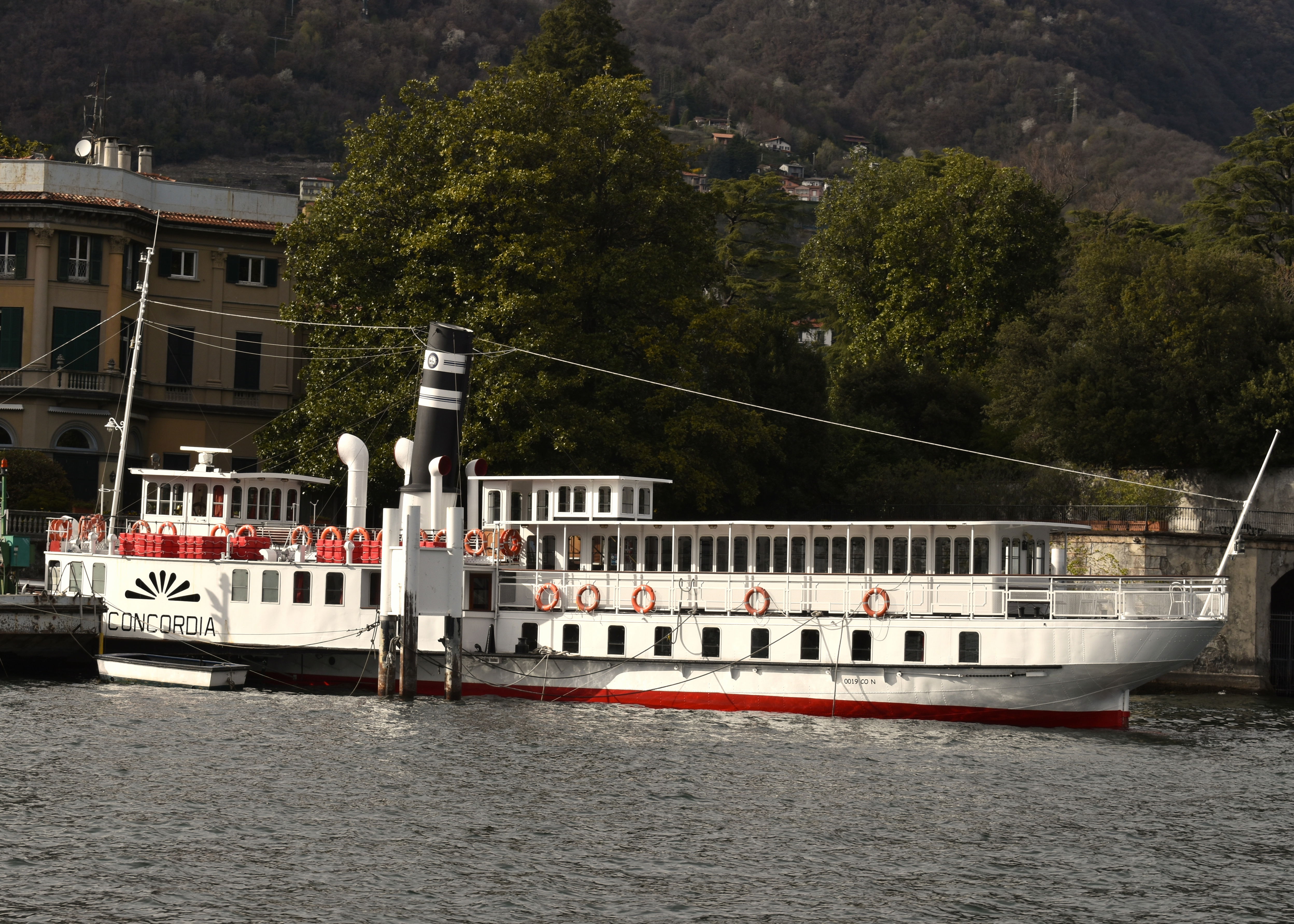
The restored lake steamer Concordia. Having been damaged by an allied air attack and repaired, it is now used for occasional cruises on the lake
Disembarking from the ferry, we cross the road into Piazza Cavour. As a pre-war Lakeside resort. Como was well provided with large hotels and the Germans, as they had done in Milan took full advantage of this. German troops were based in the Hotel Metropole Suisse on the right-hand side of the square. One imagine, that the officers got the best lakeside view. Further down the lake front, the also occupied the Grand Hotel Plinius, as well as the Barchetta , San Gottardo, Terminus and the Firenze where the officers mess was located.
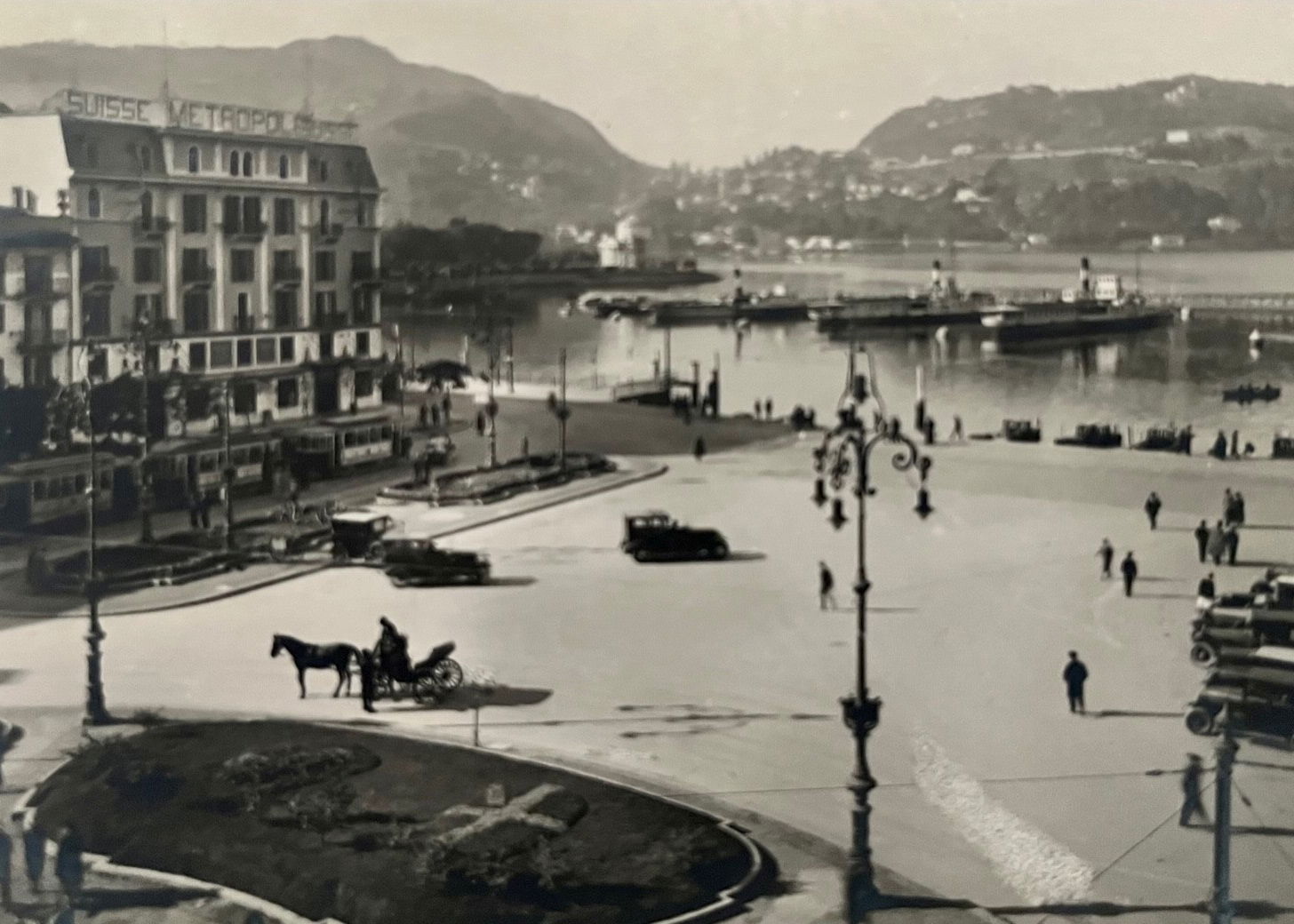
Piazza Cavour and the Hotel Metropole Suisse before the war
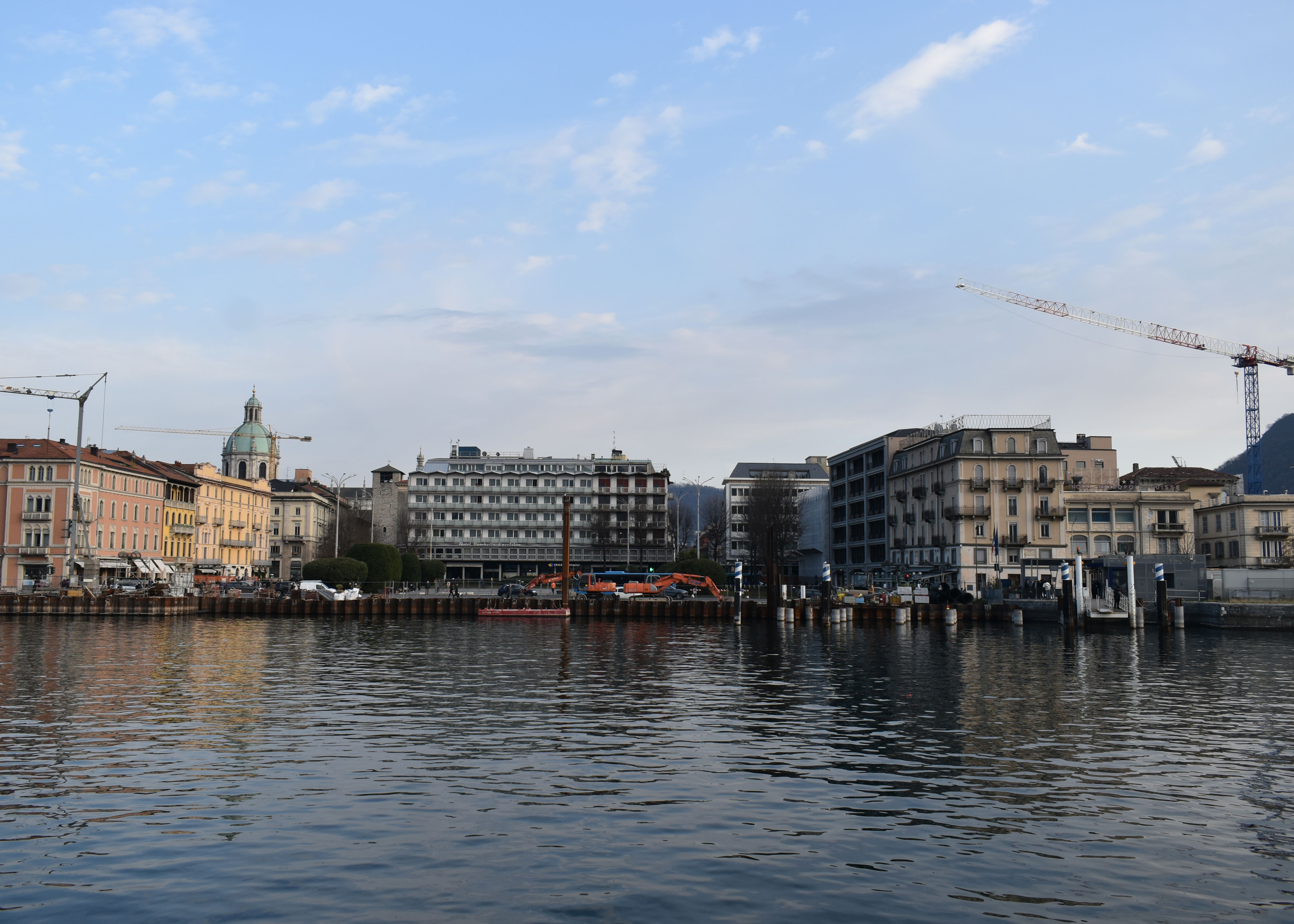
Piazza Cavour in Como from the lake. The Hotel metropole Suisse is on the right hand side. The modern building in the centre, is the Excelsior Barchetta. Clearly not the original one.
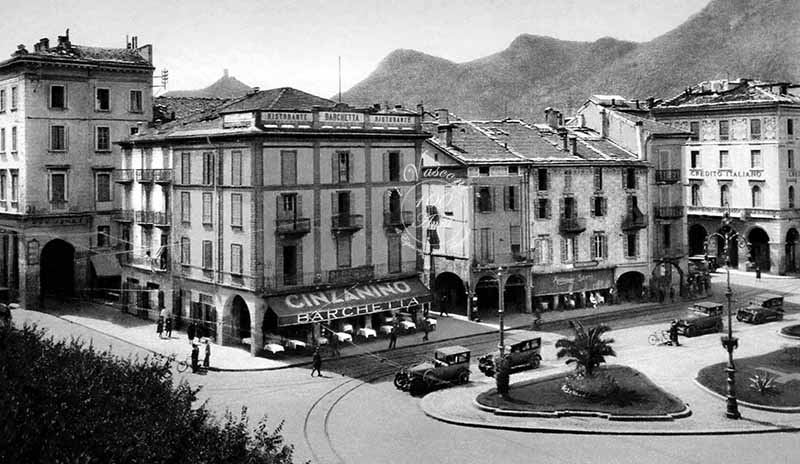
The former Ristorante and Albergo Barchetta on Piazza Cavour
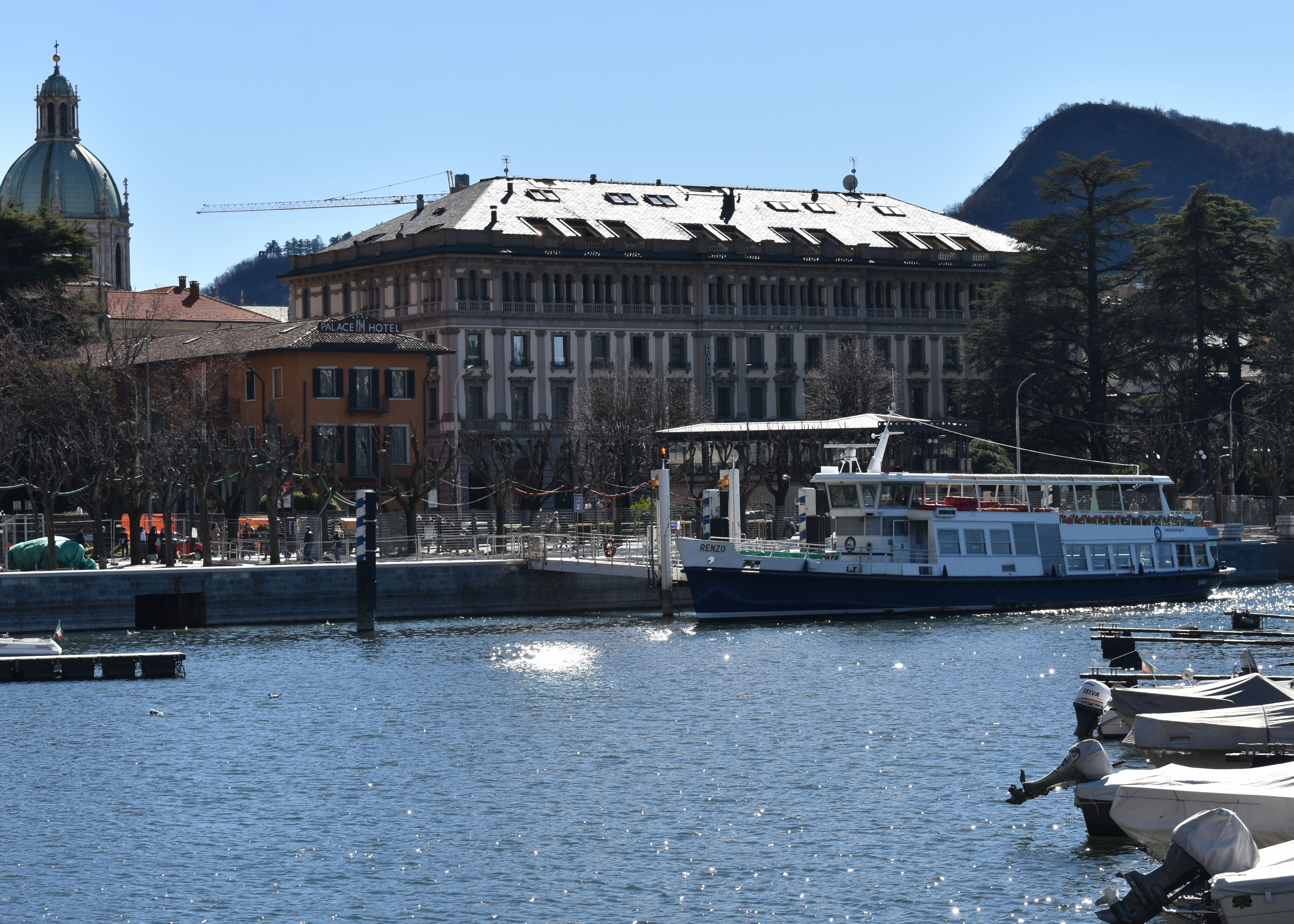
The Palace Hotel on the Como waterfront, formerly the Plinius
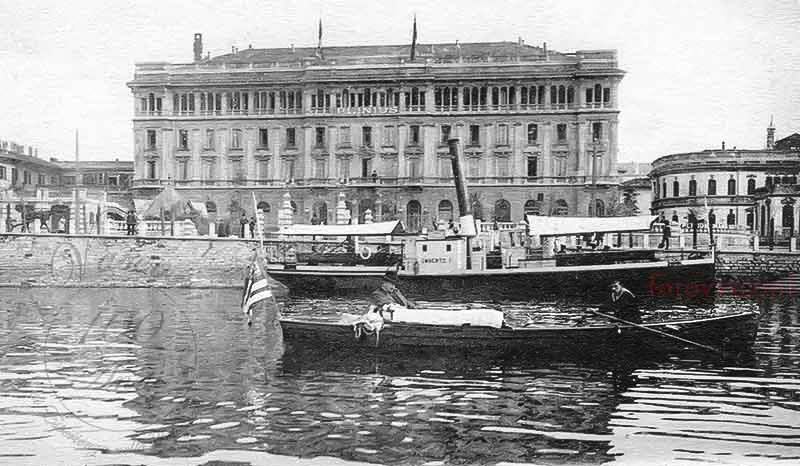
The Grand Hotel Plinius in the early 1900s
Leaving the Piazza Cavour for the Piazza Duomo, we pass the front of the Cathedral. Turing left by the cathedral and heading down the side, you can take the designated crossing across the railway line and in front is the Casa del Fascio. Constructed between 1933 and 1936, the Casa del Fascio is described as masterpiece of Italian rationalist “ architecture and is now on the Italian listed building list. It is another building designed by Giuseppe Terragni, who seems to have left his mark on Como. As well as housing the offices of local Fascist officials, the Casa also contained a shrine to Fascist martyrs and the Salone delle Adunate ( literally the meeting or assembly room) , a grand central hall with frescos by local abstract artist Mario Radice. The shrine and the frescos were dismantled at the end of the war. The building is now occupied by the Guardia di Finanza. The building was far from being some sort of benign Fascist community centre, the years of the RSI it was a place of imprisonment and torture for captured anti-Fascists , partisans , and enemies of the sate in general. Behind the Casa del Fascio was rather conveniently the German Platzkommandatur, the Headquarters of the German occupying army in Como.
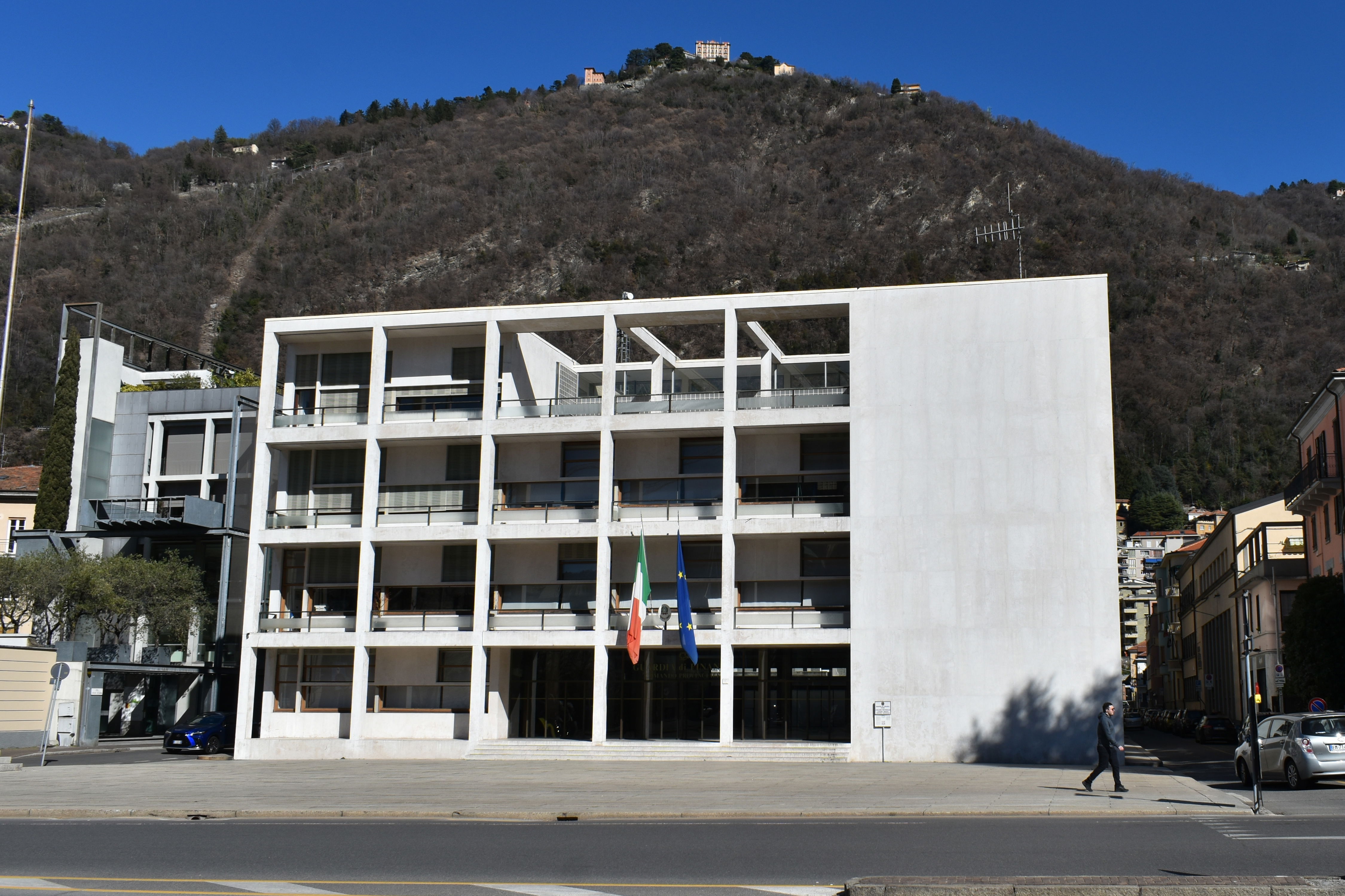
The former Case del Fascio in Como, designed by local architect Giuseppe Terragni and now the local HQ of the Guardia di Finanza
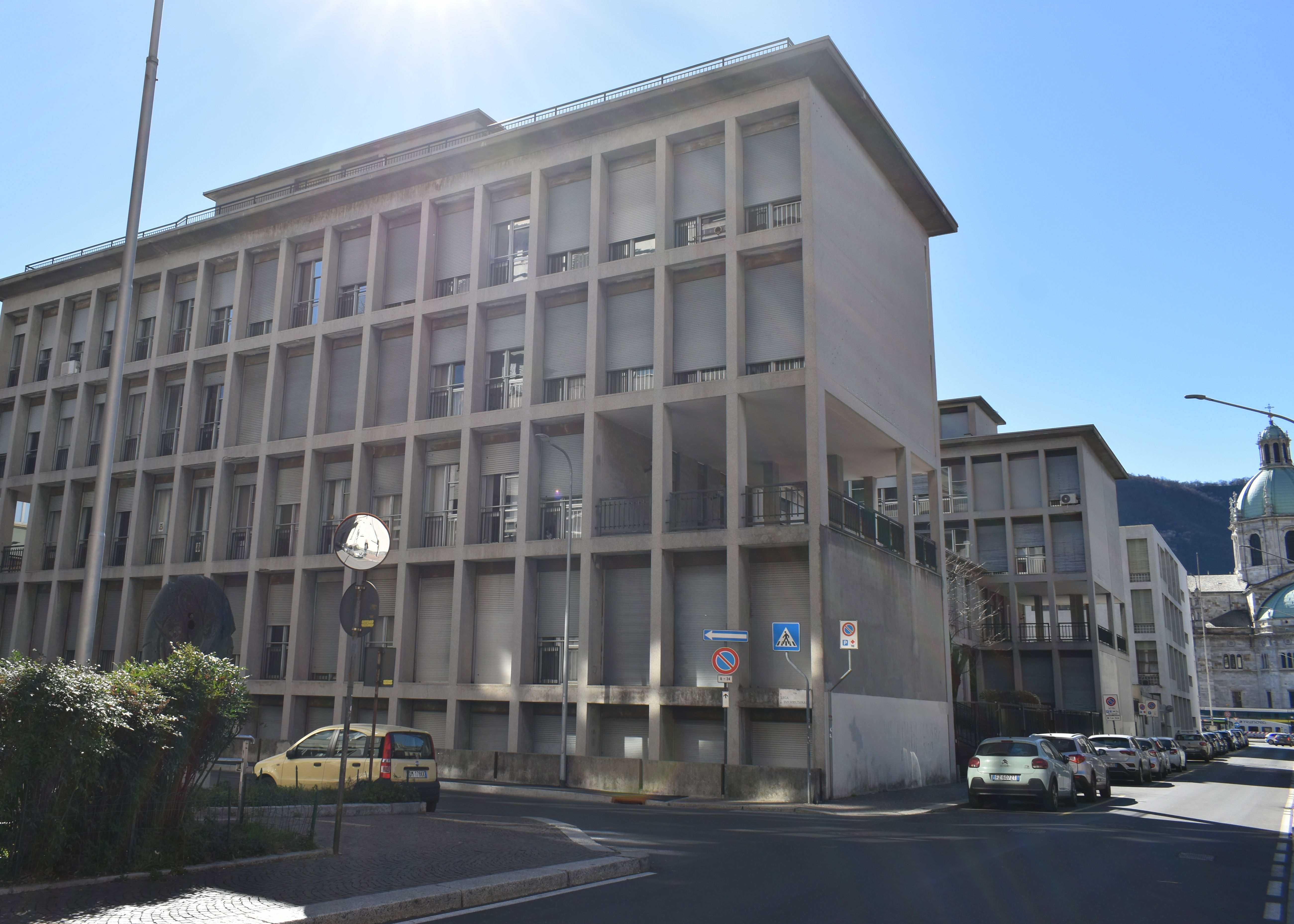
The rear of the Casa del Fascio, which housed the German Platzkommandatur for Como
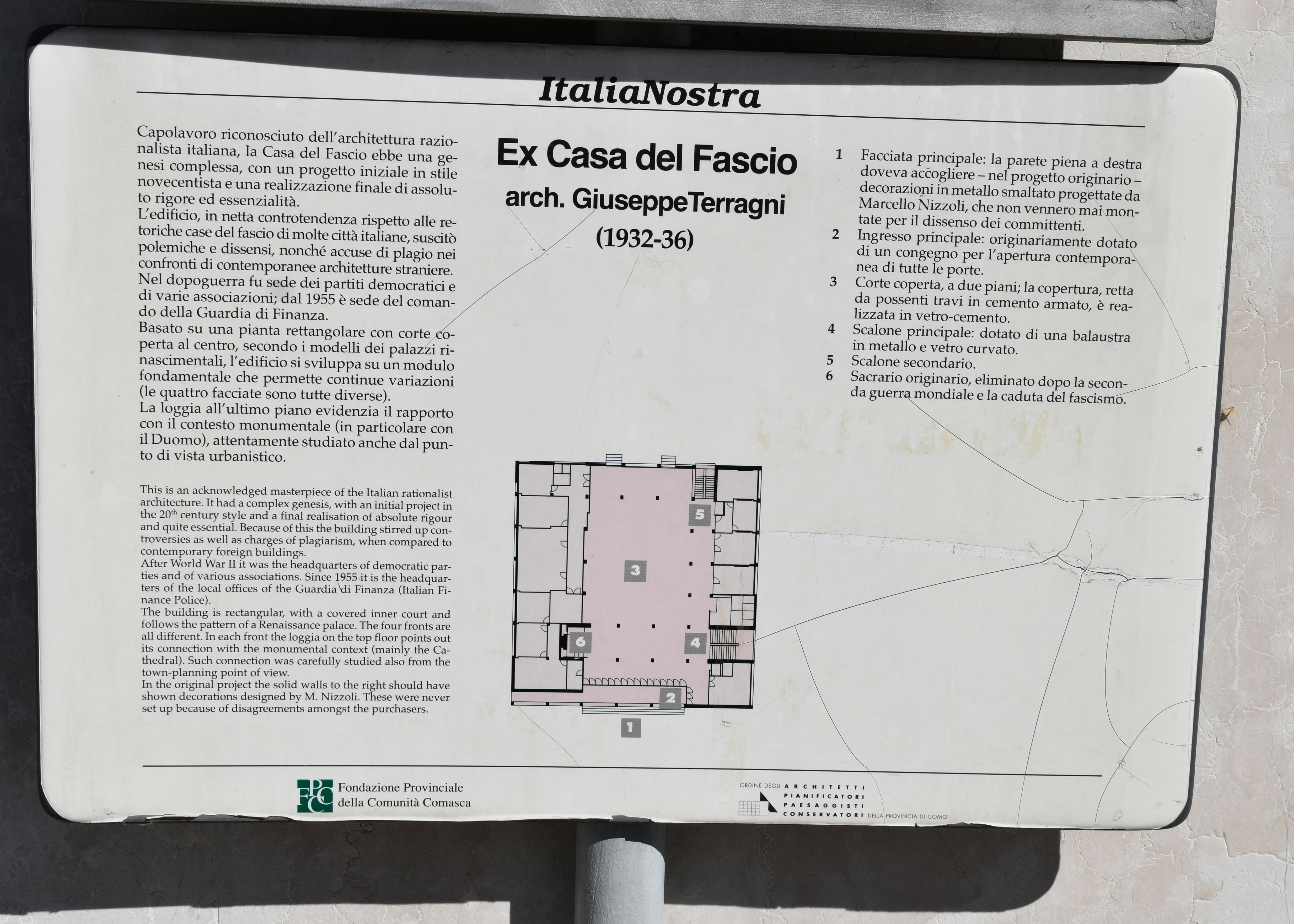
Descriptive sign outside the Casa del Fascio
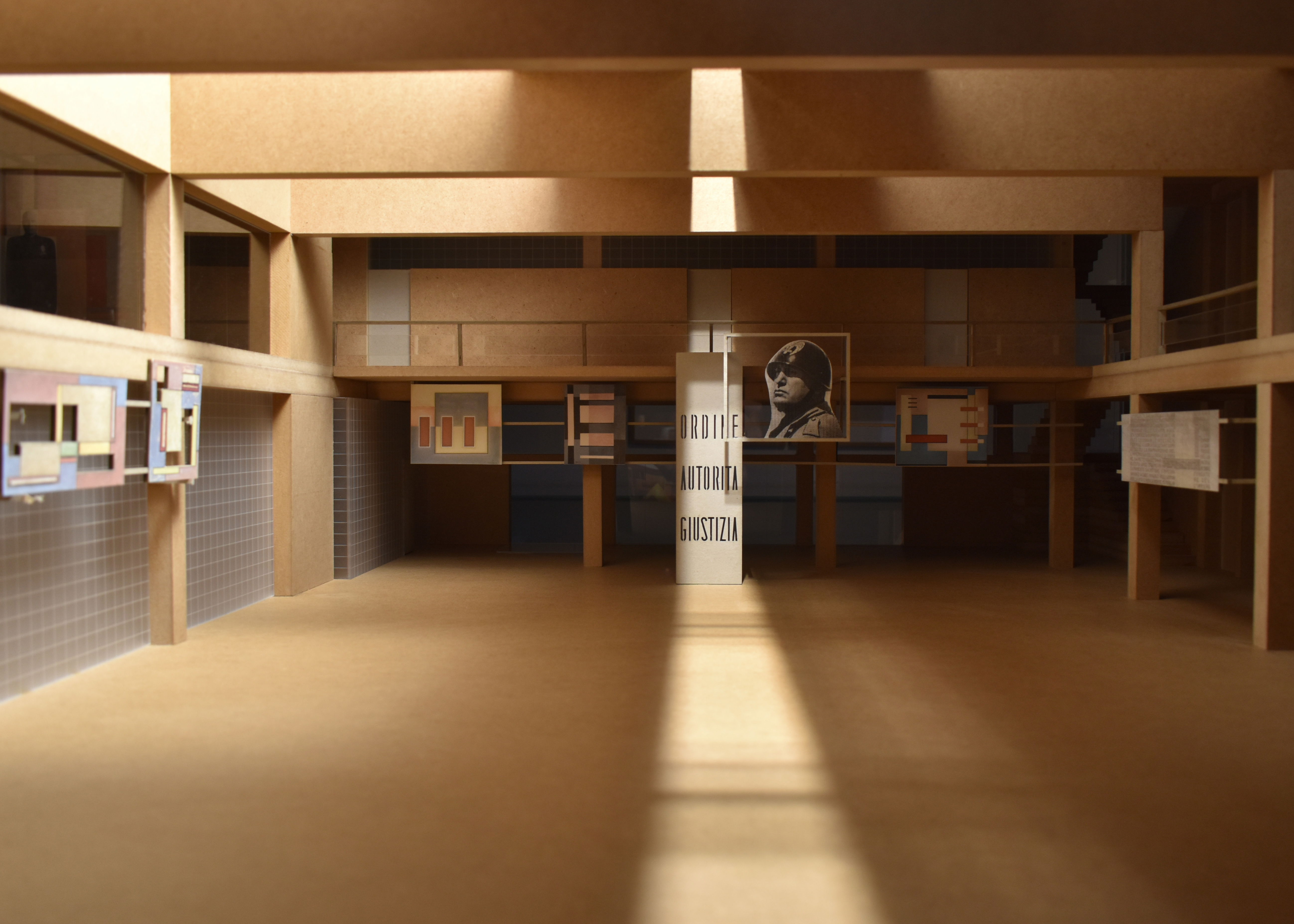
Model of the inside of the Casa del Fascio from the Civic Art gallery
Back in the centre of town we can find the former Prison of San Donnino , not that it is easy to spot, being identifiable by an unwindowed wall and a large gate on via Giovio. The prison named after the nearby church of San Donnino was constructed in the middle of the 18th Century under Austrian rule and attached to the back of the Palazzo Volpi which the Austrians used as court building. Behind the austere walls, it was a prison for 150 years right in the middle of the city, yet closed off to public view. It was divided into male and female wings, and apart from common criminals was also used to detain political prisoners at various times Italian patriots during the Risorgimento, antifascists during the Fascist period and Fascist gerarchs and collaborators after the liberation. Most tragically, it was one of the first stopping off point for Jewish Italian caught trying to cross the frontier into Switzerland and the first stopping point on journey which usually led then to Milan’s San Vittore Prison and then onto final destination Auschwitz, Almost unbelievably to look at the outside, it continued to function until the early 1980s, when Como's prisoners were moved to a more suitable location on the outskirts of town.
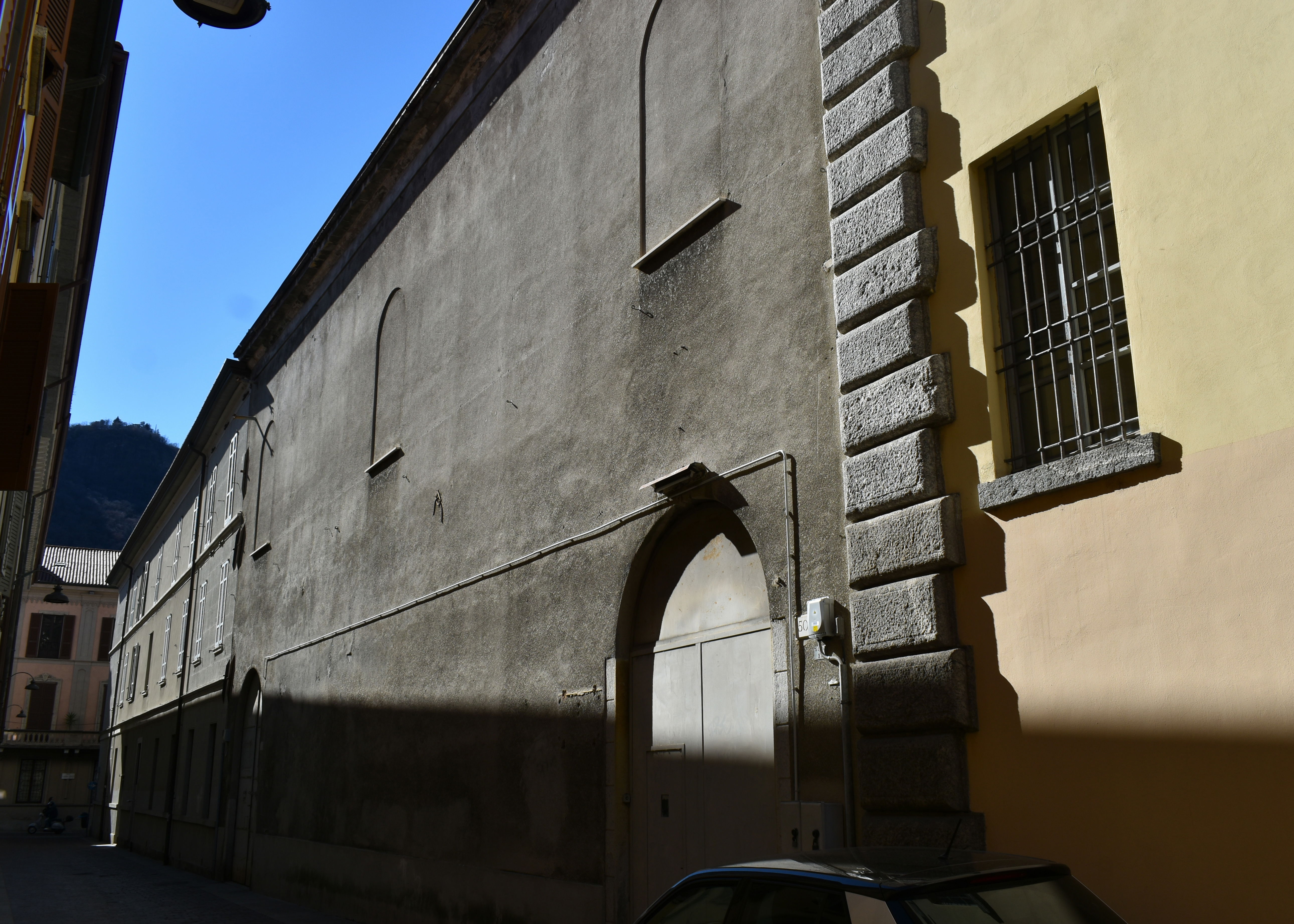
The entry door and walls of San Donnino Prison in via Giovio
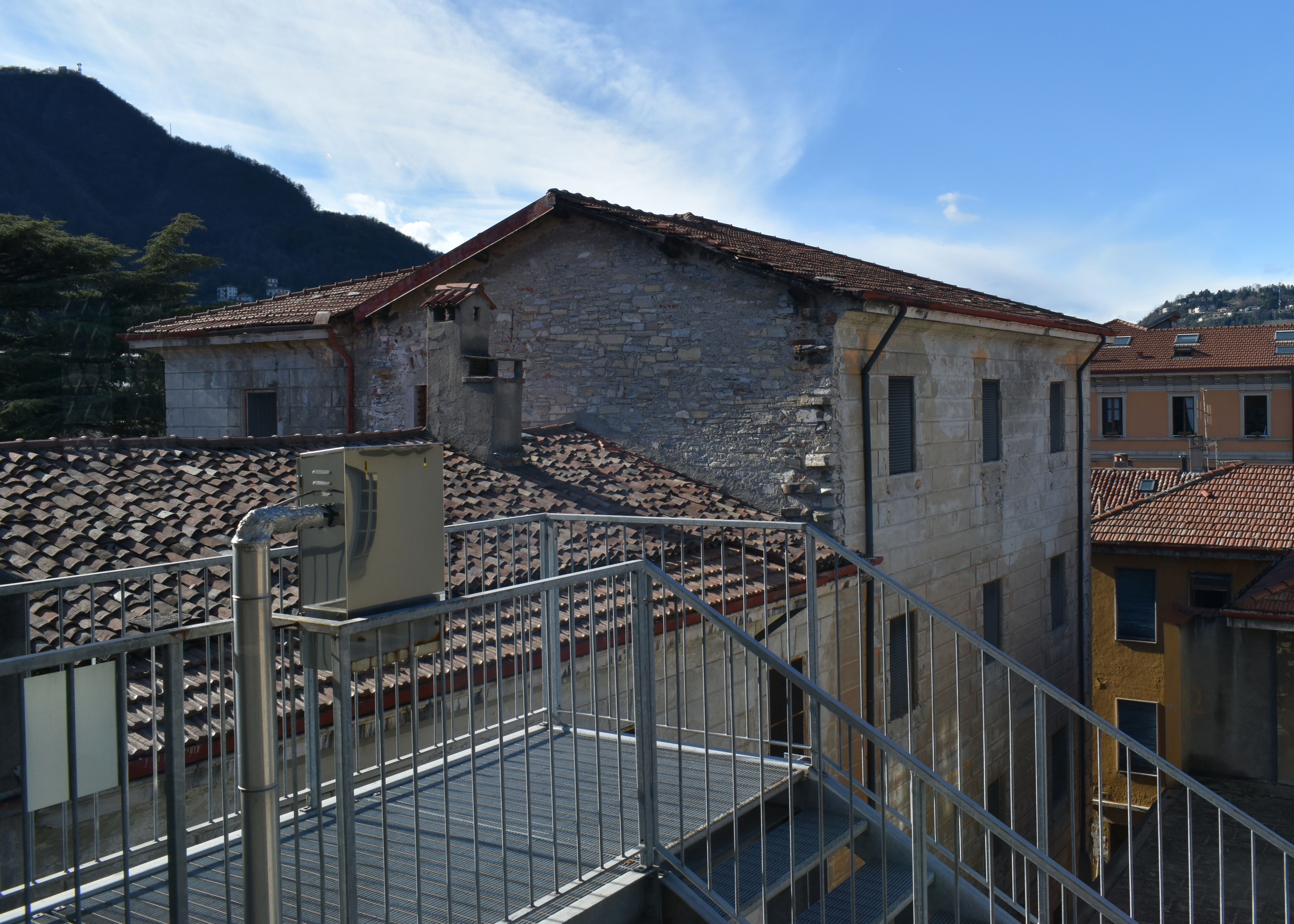
A view of the inside of San Donnino prison from the top floor of the Civic Art Gallery
One of the more notable inmates of San Donnino was British SOE agent ; Dick Mallaby. Mallaby’s extraordinary exploits deserve a book of their own ( in fact they have one ) To cut a long and complex story short ( since it is much better told in the book). Mallaby whose family had lived for many years in Italy was into the SOE , where he was responsible for training Italian agents to infiltrate into Italy. After a series of notable failures, mainly attributable to the infiltration of double agents by SIM ( Italian Military Intelligence ), it was decided to parachute Mallaby himself into Italy. Although thanks to his upbringing, he spoke fluent Italian ( allegedly better than his English), Mallaby was tall blond and unmistakably English looking. The plan was to parachute him into the middle of Lake Como, where he would inflate a raft and to paddle to the shore to rendezvous with some Italian contacts. The planners anticipated Lake Como would be dark and he would make land undetected. However, he arrived at Lake Como on 14 August 1943, in the middle of an air raid on Milan, which left the fires of the city illuminating the horizon. Worse still, the mass of refugees who had fled Milan appeared to be ignoring the blackout and the lakeside was more illuminated than expected. The unfortunate Mallaby was probably spotted as he left the plane, and it was not long before the Italians sent several boats out to retrieve him. He was lucky that Northern Italy was not yet under German occupation and the Italians chose not to execute him as a spy. Instead, he was shuffled between prisons , down to Milan’s San Vittore Prison and then back to San Donnino .
Mallaby had arrived in Italy during the 45 days between Mussolini’s fall from power and the Armistice. At the time several senior Italian officials were trying to negotiate an exit from the war. These included General Castellano , who had made the long and risky journey by train from Rome to Lisbon to meet with Allied Officials. He then made an even more risky journey back through occupied southern France with the draft surrender document , for safety this was entrusted to the Italian Ambassador to Chile who was on the same train as part of an exchange of expelled diplomats. Castellano needed a liaison with the Allies and so Mallaby was whisked off to Commando Supremo in Rome to transmit messages to the Allies. . After a few tense days of relaying message in Rome , the Italian Armistice was announced on 8 September. Mallaby was evacuated by air to Pescara, where he joined the Italian ship Baionetta which was evacuating Marshal Badoglio, the Royal Family and most of the General Staff. After this long adventure, he arrived in Brindisi, where he was able to catch up with some mates from the SOE for a drink in the Hotel Internazionale.
It might be thought that Mallaby would have had enough of Northern Italy, but on 14th February 1945 he crossed the border from Switzerland on a mission to meet up with Italian partisans. Crossing through the Val Cavrana, the group ended up in Menaggio and crossed the lake to Varenna in a rented boat. They were supposed to head for Bergamo, but due to a lack of transport diverted to Milan instead, They were arrested near Lecco , Mallaby told the story that he was on a secret mission entrusted with a message for the Italian military leader Rudolfo Graziani. So late in the afternoon, Mallaby returned to Como, to be interrogated by Paolo Porta, the Federale of Como and Head of the local Brigata Nera. Mallaby was then taken to Milan to meet with General Edoardo Facdouelle , Chief of Staff of the Brigata Nera. after that he was handed over to the Italian Counter Intelligence service, the SID in Volta Mantovana ,. In the end Mallaby was handed over the Germans and taken to the SD Headquarters in Verona After interrogation, he was somewhat surprised to be sent to Fasano on Lake Garda to the HQ of Gruppenfuehrer Wolff. By another turn of good fortune, Wolff was secretly engaged in discussions with the Allies to surrender the German Armies in Italy and decided to use Mallaby as go between. On 28 February Mallaby was escorted by the Germans back to Cernobbio. On 1 March he was escorted by the Germans to the border at Chiasso. Here he found that the Swiss border police, who should have been advised of his identity were not and he taken into the custody, spending a week in a detention camp in Bellinzona, before the British obtained his release.
When the war ended, San Donnino prison began to fill up with Fascist Prisoners. Among the temporary prisoners were Rachele Guida, Mussolini’s wife – who maybe have been quite glad, that he decided to take the unfortunate Claretta Petacci on his last lakeside trip. Also passing through San Donnino was Vito, Mussolini’s nephew ( not to be confused with son Vittorio who had fled elsewhere.) Many of the Fascist prisoners were detained in cell 31, a large cell with a terrible lack of bathroom facilities, When the Fascists pointed this out to their goalers, they were reminded in no uncertain terms that they had responsible for the prison for the last 20 years and had done nothing to improve the facilities. Some of those imprisoned were tried in the Assizes court for crimes omitted during their temporary lordship over Como. They included the Questore of Como, Lorenzo Pozzoli .Pozzoli was tried for his complicity in the murder of Alfredo Vacchi, a math teacher who has operated a radio in contact with the Americans on behalf of the CVL. Vacchi had nipped out for a rather unfortunately mistimed cigarette break after one of his transmissions and was murdered by a Fascist squad at the cemetery in nearby Camerlata. Pozzoli had not been present , but was put in the frame by vice Questore Domenico Saletta , who headed the UPI ( the political police ) in Como. In fact, Pozzoli had a fairly moderate reputation by the standards of local Fascists, so much so that he had been urged to leave the city on its liberation by local Christian Democrats. . He was picked up later at his home in Varese. While Saletta incriminated him, Pozzoli was defended by fellow prisoner, the ex- perfect Celio who testified that Pozzoli had saved several thousand young draft evaders from deportation to Germany Despite favorable character witnesses, Pozzoli was sentenced to death. An appeal for clemency to General Cadorna, n in Military command of Milan was refused. Also sentenced to death were the ex vice commissario Saletta and two other Public Security officials. They were taken out of San Donnino prison at 4.30 and transported to the lakeside near the War memorial. At 6,05 they were executed by firing squad, in the still quiet morning the shotes were apparently heard in the prison.
The Assizes court building, the Palazzo Volpi, is now the Civic Art Gallery for Como. In fact, the only way you can currently get to see a bit of the prison is to visit the top floor of the art gallery and look out of the back windows. Although there are some interesting displays of medieval church interiors and some Renaissance art, the top floor with its 20th Century Gallery is worth a look. Here among the display of the works of Terragni and other local architects, there is a large-scale model of what the inside of the Casa del Fascio looked like, before it was “deFacisted”, although in wood rather than black marble , it does give an impression of the scale of the place and its now removed internal decor. There is also a display of works by local painter Radice, some of which ae similar to the frescos displayed in the Casa.
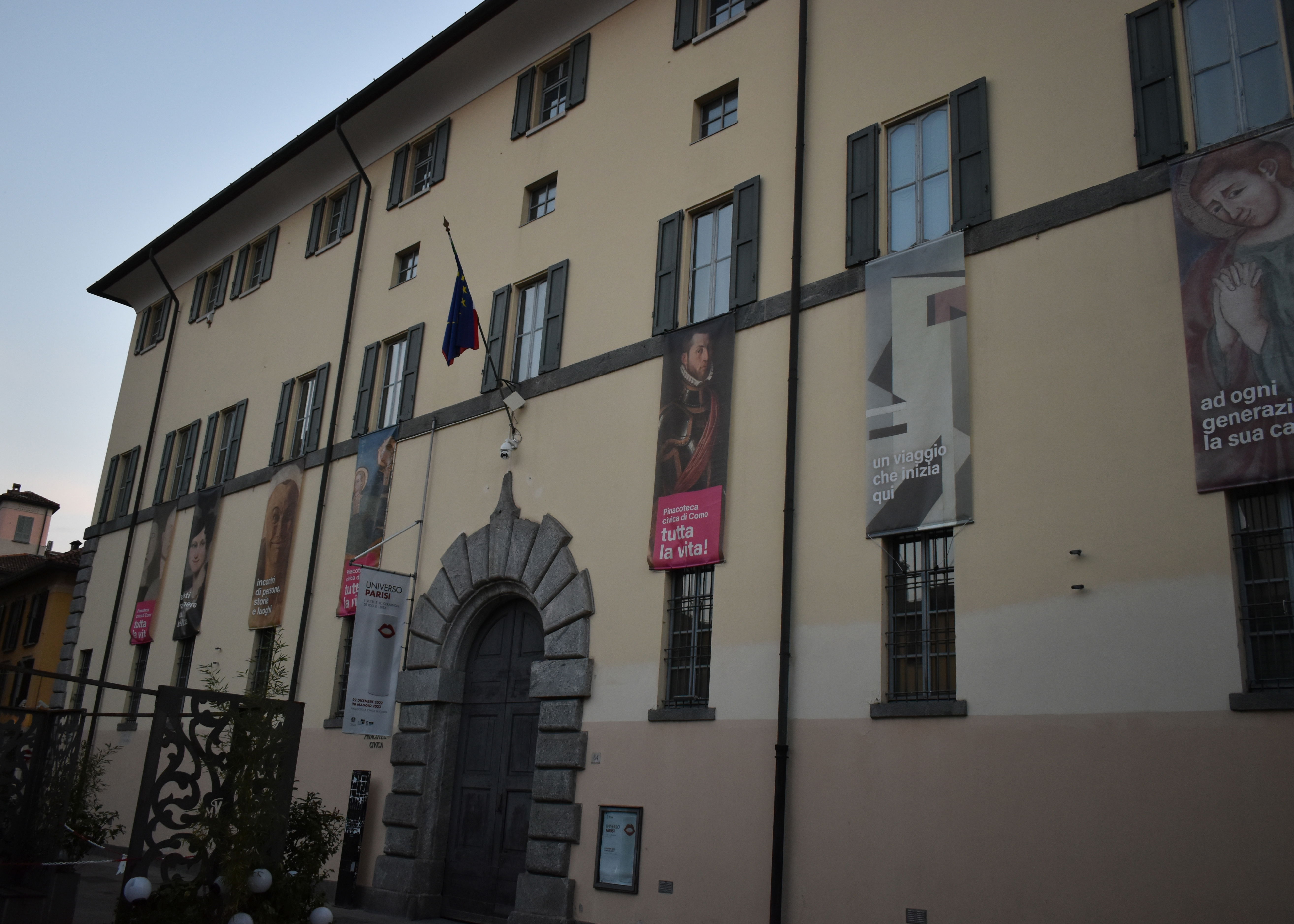
Palazzo Volpi, used as an Assizes Court by Austrian occupier, then the Germans. Now the Civic Art Gallery in Como

Heading out of the piazza Cavour in the other direction, one passes the hotel Terminus and the hotel Palace ( formerly the Plinius) both of which were used as accommodation by the Germans. Passing by the Como lakeside station. One arrives at the bus station . Tucked away by the behind the bus station is the Palazzo Saibene, which housed the German Feldgendarmarie ( the Military Police). Dating from the 17rth century and reconstructed in the 19th. There is nothing much to see , just a courtyard behind a closed gate.

The Palazzo Saibene, near the bus terminal
Walking away from the bus station along the lake side , pass by the bars and restaurants, which look ideal for a later aperitivo. The first notable building is the former Swiss consulate. This was an anomaly, since the Swiss did not actually recognise the RSI, apart from Germany , Japan and a couple of other Axis nations – nobody recognised the RSI. The Swiss legation stayed in Rome and in common with the other the other neutral powers Sweden, Turkey and Spain continued to recognise the Kingdom of Italy as the legitimate government of Italy. Nevertheless, the Swiss had maintained a Consulate in Rome and following the Allied bombing of Milan in August 1943 had moved out to the safety of Como, where they continued to provide consul assistance to the Swiss population. In the end the Swiss appointed a commercial representative to do business with the RSI, while not formally recognising it. The Swiss Consul, Mr Brenni provided a final service by, along with his compatriot Colonel Martinoni, helping to negotiate the surrender of a formidable group of Germans who were threatening to cross into Switzerland from nearby Ponte Chiasso.
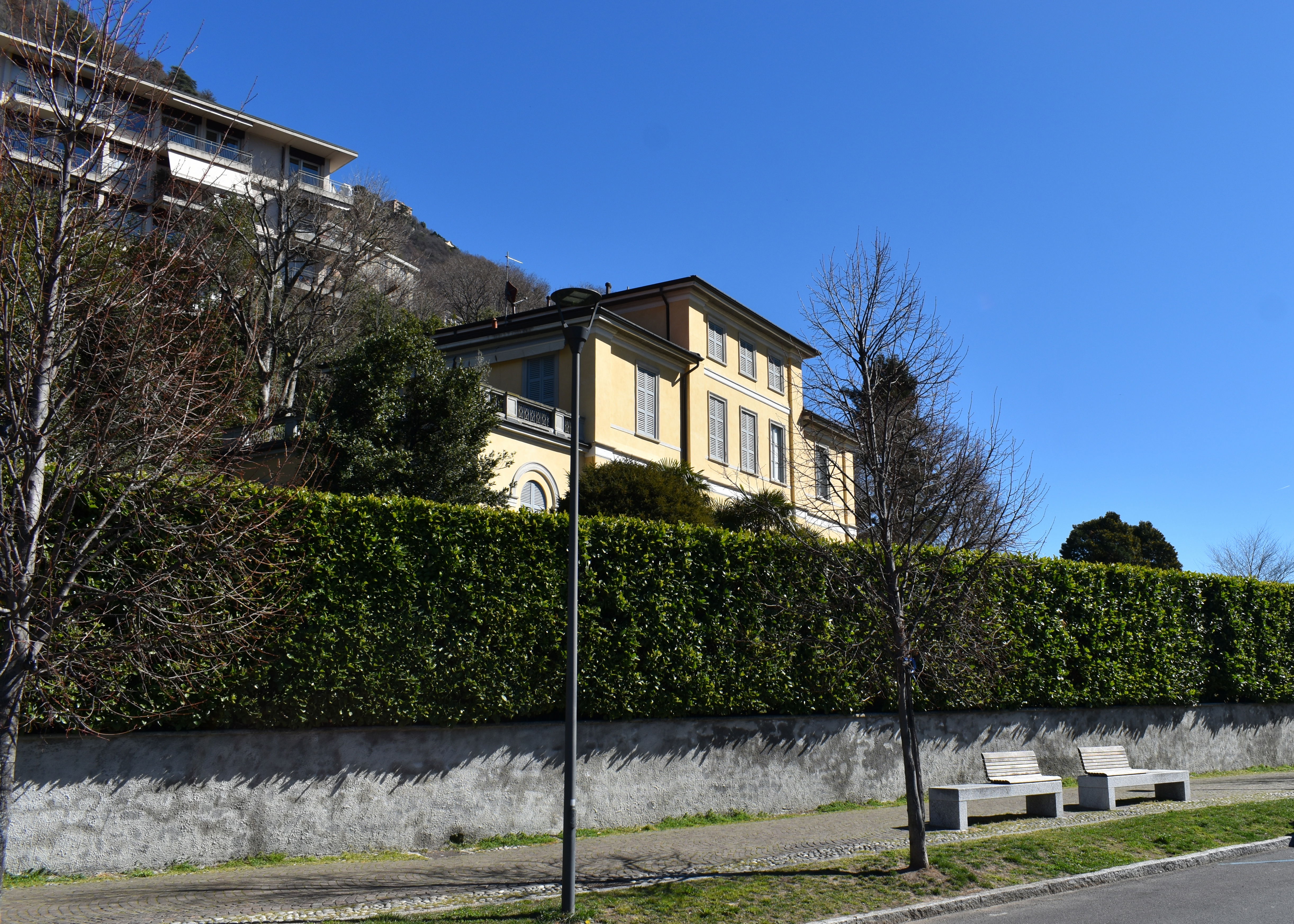
The former Swiss Consulate on the lakeside. It moved there to get away from Allied bombing of Milan
A hundred metres down the lakeside is the villa Taroni, which housed the XIV Compagnia of the Guardia Nazionale Repubblica . The GNR was the gendarmerie force of the RSI; which had replaced the Fascist militia the MSVN and the real carabinieri , which had been abolished in the RSI due to its Royalist loyalties.
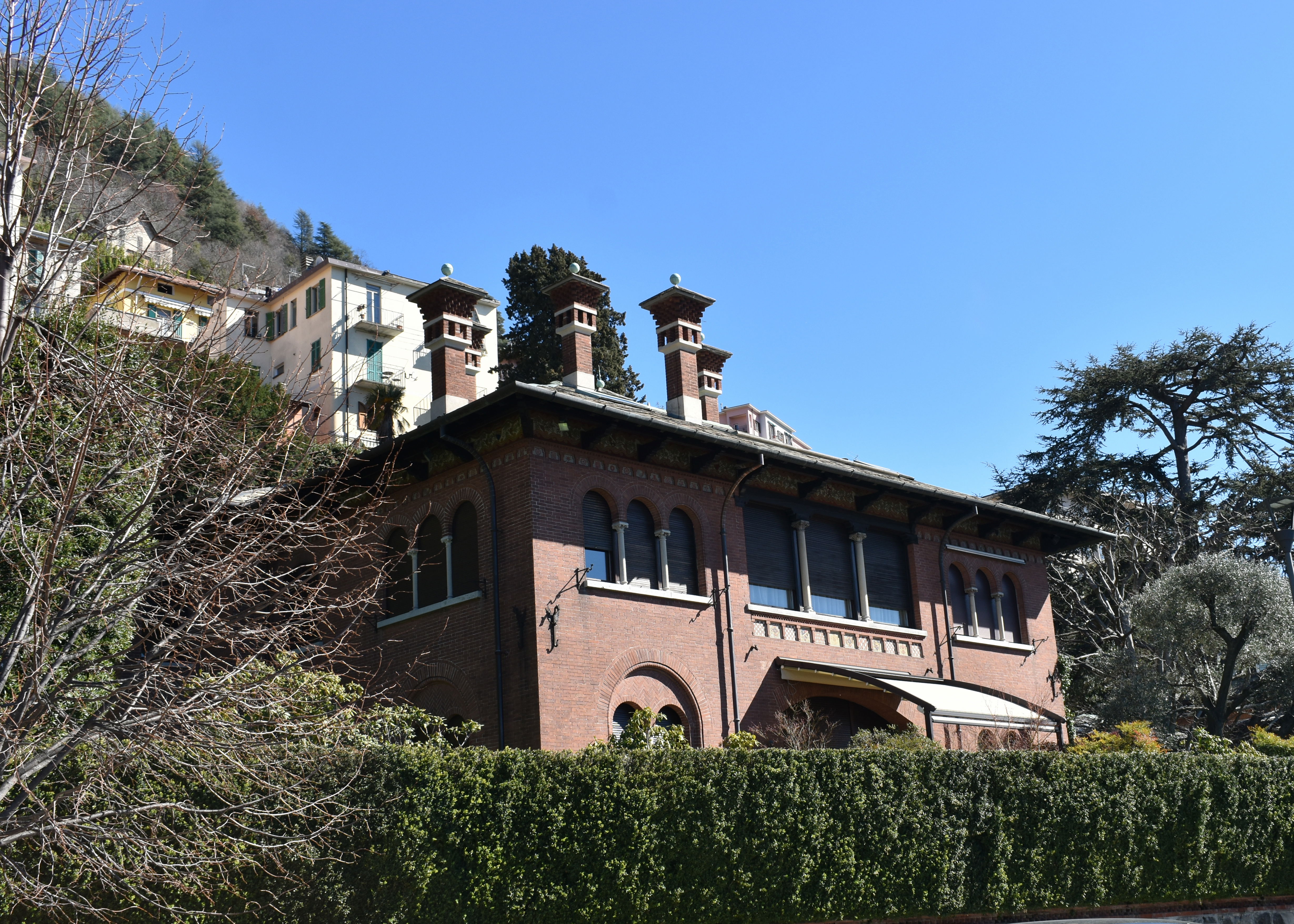
Villa Taroni on the lakeside, used by GNR Militia
Finally at the edge of the lake shore and commanding a spectacular view is the Villa Geno, which housed the German Border Police and commanded a spectacular view across the lake.
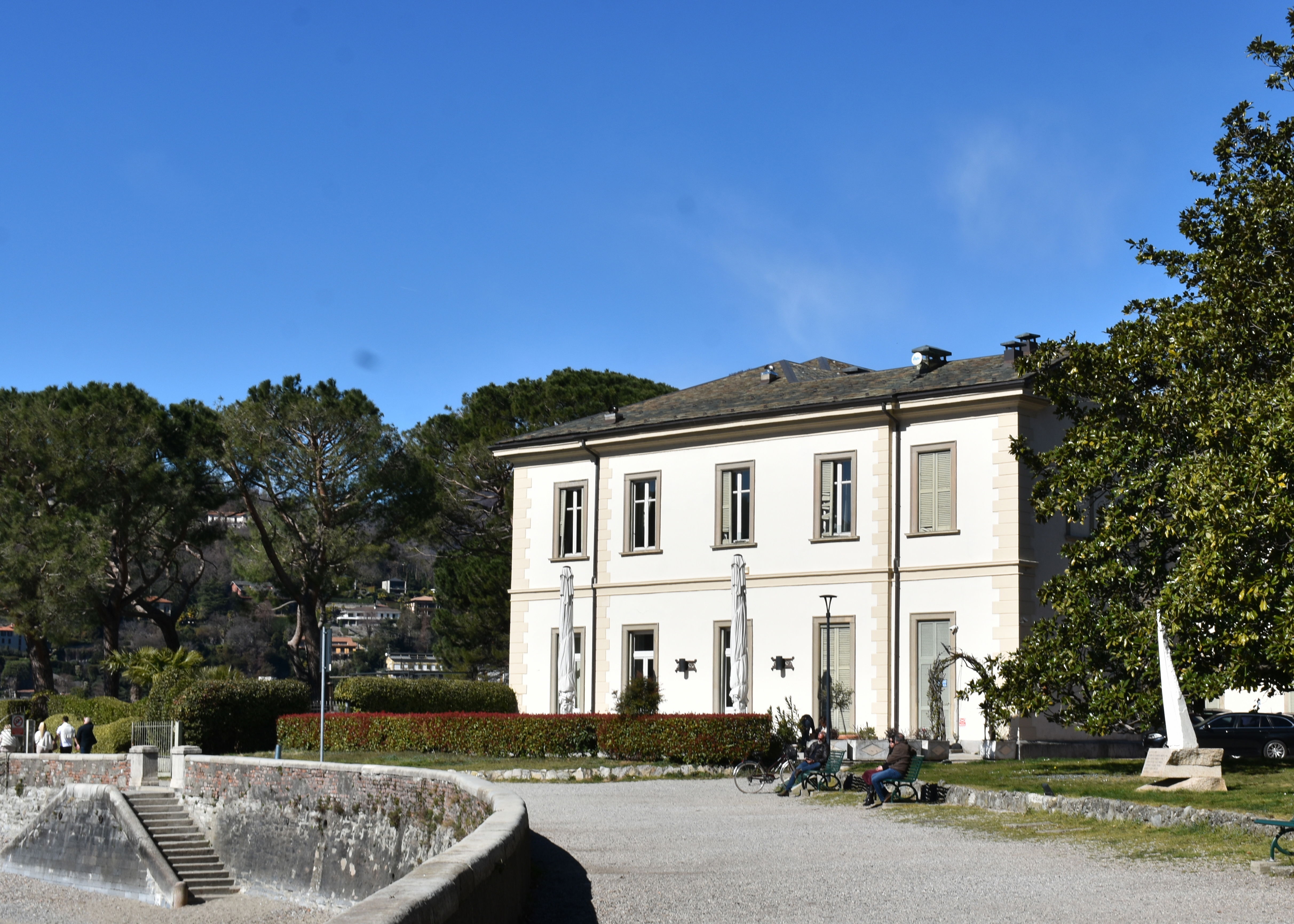
Villa Geno, base of the German Border Police
Passing back in front of the Casa del Fasci ad heading along past the railway line is what used to be the Palestra Mariani, which was used as a prison by the Brigata Nera, especially notorious for the detention of strikers imprisoned atter the General strike of March 1944, The two school buildings round the corner in via Perti were used as accommodation for the Commando Provincia GNR and as a vehicle depot. Continuing past the Palestra and along by the remains of the city walls, you reach the wide via Cesare Battisti.
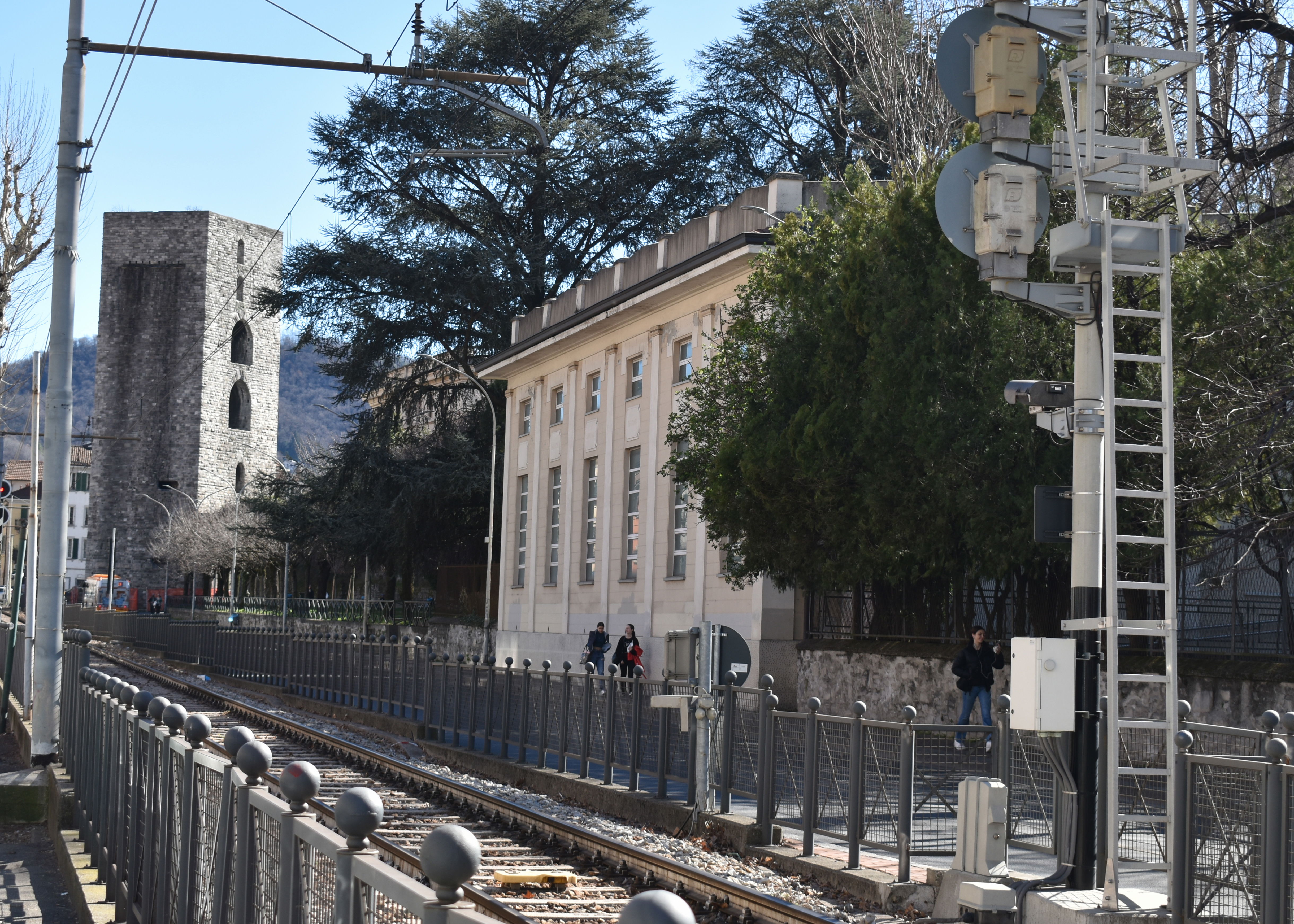
Palestra Mariani, used to detain strikers by the Brigata Nera
On via Sirtori is the impressive Municipal market, and at the end of the block was the HQ of the Brigata Nera “Cesare Rodini “ . The Brigata was commanded by Paolo Porta, and was made up of a Command HQ and two operational battalions. The 1 battaglione commanded by Maggiore Mario Noseda and the 2 battaglione under Maggiore Plinio Butti. Both were notorious for their anti-partisan sweeps in the hills above Como and around the lake. The Brigade was named for Confinari GNR Cesare Rodini, a border guard who had been killed in an anti-partisan sweep in val Pelice in piedmont.. Any member of the PFR could enrol in the Brigade and in the end the Brigade consisted of 787 squadristi volunteers. They were infamous for their killings of partisans.
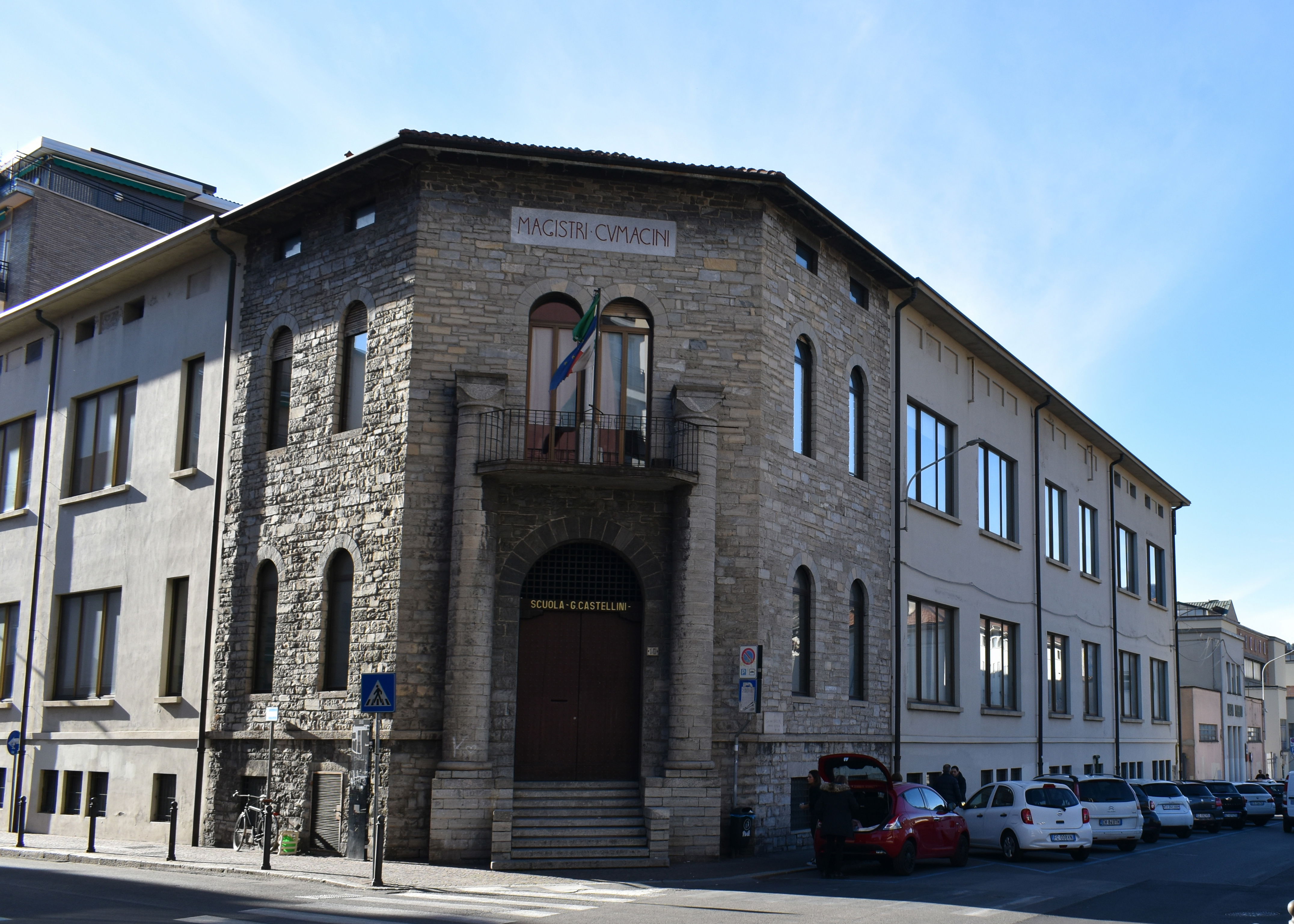
The former HQ of the Brigata Nera “Cesare Rodini “
As mentioned, Como was a centre of the silk industry, with many factories producing dyestuffs. These have mainly demolished. A small part remains of one of the biggest, TICOSA ( Tintoria Comense Società Anonomina), , founded in 1871 , it was taken over by the French company Gillet & Fils, and expropriated when the Italians declared war on France in June 1940. TICOSA employed thousands. On 6 March 1944, the general strike here was initially successful. Unfortunately in repressing the strike , nine employees of TICOSA and the neighbouring Tintoria Castana were rounded up. They were probably identified by the management , and sent to the Palestra Mariani then with hundreds of other North Italian strikers to a barracks in Bergamo, from where they were deported to camps in Germany. In all some 1200 Italians who participated in the March 1944 strike were deported, most never returned. From Como, seven of the nine deportees to Germany, never returned. Two women, Ines Figini and Alda Borgmanebvt returned home. Ines Figini, was neither a partisan or an active anti-Fascist, shew was simply striking for better pay and conditions. She did the rounds of the camps at Mauthausen, Auschwitz-Birkenau and Ravensbrück before final returning to Italy In a certain irony, SS Brigadefuehrer Paul Zimmerman, responsible for the ruthless repression of the Italian strikes, was billed in a palazzo in Blevio on the other side of Lake Como.
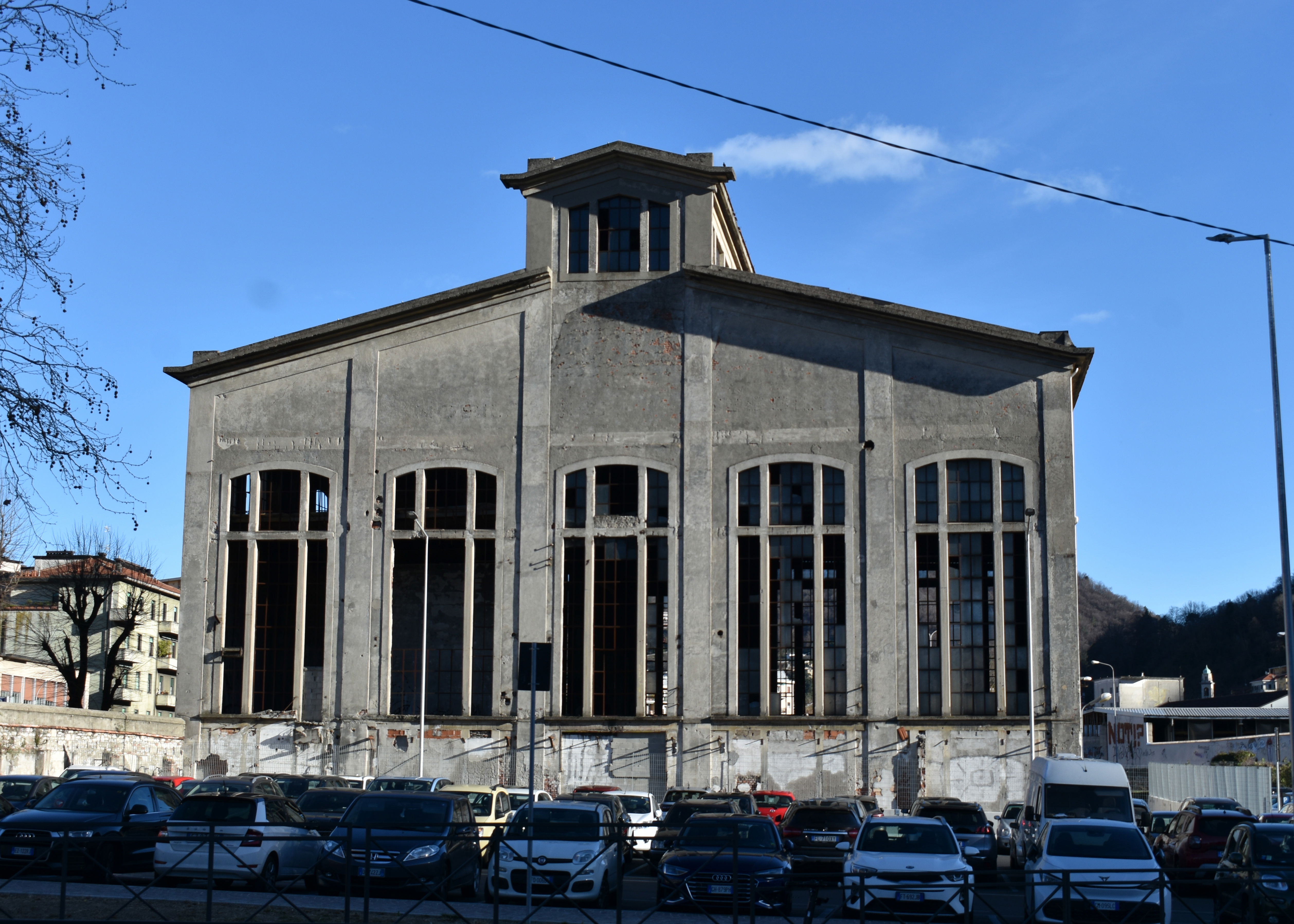
All that remains of the TICOSA dyeworks, which formerly employed several thousands in Como
As the Germans tightened their grip on Milan , many of the city’s Jewish residents fled to Brianza, Como and surrounding areas, specifically having in mind the proximity to the border with Switzerland, which in many parts of Como was only a short walk away. However, following their invasion, the Germans had acted swiftly to seal the border with the assistance of Italian Militias. The main border crossings were impossible to use , so those who needed to cross were constrained to pay people smugglers to get them across. Usually these were former contrabanders who knew the backways across the border. Some of them acted honorably and did what they were paid for, others took the money and promptly handed their clients over to the authorities. Even if they got to the border, it was by no means certain that the Swiss would let them enter and unfortunately some were sent back again. Most of those who failed to cross the border in the Como area ended up in Como Prison and when that was full , at the Caserma de Cristoforis, where they waited to be sent to the Jewish wing at Milan’s San Vittore Prison , to the Fossoli transit camp or towards the end of the war to Bolzano , before being put on a deportation train to Auschwitz . A number of the Jewish residents of Milan, who are now commemorated by the Stolperstein outside their former houses passed through Como on their way to the Camps. Aurelia Allegra Levi Finzi stayed on in Milan despite the pleadings of her family to leave. On 25 October 1943 she finally tried to cross the Swiss border with her daughter Emma. They were arrested in Como and passed through various local prisons before being murdered at Auschwitz. Guido Levi and his wife Olga Luigia Ascoli Levi had moved to Como from in 1943. They believed that because of their advanced years nothing would happen to them , They were arrested in Como on 23 September 1943, deported and murdered at Auschwitz.
In all that terror and sadness, there were some rays of light. One of these was Luisa Andreani ( nee Colombo) , a 23-year-old Red Cross worker who risked her own life to save Jewish detainees in Como. Luisa’s father owned a shop near to the barracks and through customers among the guards, he heard what was going on in the barracks and asked Luisa if she could help. With the aid of one of the guards she gained access to the barracks, initially just spreading kindness and comfort to the prisoners. Then she took a big risk and managed to smuggle four prisoners out of the barracks . Vittorio Altaras from Spalato, Mayer Haim Relles( a cantor and assistant to the Rabbi of Venice) , Captain Fritz Michaelis and Gualtiero Schubert from Milan. The escape was coordinated by lawyer, Edoardo Orsenigo, who was a friend of Luisa’s family. The four men headed for the roof of their barrack block and managed to cross to an adjacent building. Luisa set up he ladder which enabled them to get down to the street . Altaras and Relles apparently made it to Switzerland, the other two survived the Shoah. Although Luisa became of interest to the local police, she to managed to survive. Om 29 February 2004, Luisa Andreani was honoured by Yad Vashem in Jerusalem ss one of the Righteous Among Nations. One of 776 Italians to whom that honour has been granted.
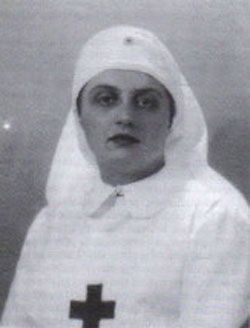
Luisa Andreani ( Colombo) - One of the Righteous Among Nations
On the evening of 27th April, the 13th Armored Regiment of the US 1st Armored Division reached Como. The 13th Regiment had landed in French North Africa in November/ December 1942 and fought its way through Tunisia, incurring heavy losses at Kasserine Pass. , elements of the 13th Armored landed at Salerno, Italy, on 9 September 1943, with the rest of the regiment arriving in late October. the 13th Armored had taken part in the fighting around Cassino and the Alied breakout from the beachhead at Anzio beginning on 23 May. Units of the 13th Armored were among the first Allied units to enter Rome when it fell on 4 June. After the fall of Rome, the 13th Armored continued to attack north with the 1st Armored Division until reaching Lake Bracciano. From there, it was a long hard struggle up the Italian Peninsula and the Po Valley , until some 18 months after they first landed in Italy, they reached Como and the Swiss border. At Como, they evicted the Germans from the Hotel Metropole Suisse and established their own HQ there instead.

With the Germans evicted, the Hotel Metropole Suisse became the HQ of the US 13tg Armored Regiment of the 1st Armored Division
Dick Mallaby's story is told in Gianluca Barneschi's book
"An Englishman Abroad", Osprey Publishing

Luisa Andreani's details from Yad Vashem